Paul van Yperen's Blog, page 303
July 8, 2017
Margit Saad
German actress Margit Saad (1929) was a mysterious, exotic beauty, who worked largely in German film and television. During the 1960s, she also made occasional English-language appearances.
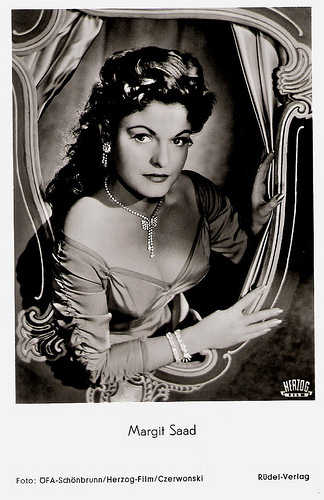
German postcard by Rüdel-Verlag, Hamburg-Bergedorf, no. 844. Photo: ÖFA-Schönbrun / Herzog-Film / Czerwonski. Publicity still for Hab ich nur deine Diebe/I only have your love (Eduard von Borsody, 1953).
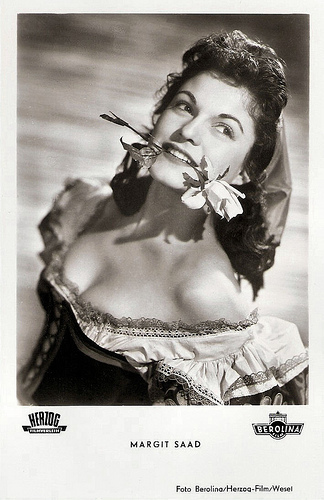
German postcard by Kunst und Bild, Berlin, no. A 1128. Photo: Herzog / Berolina. Publicity still for Der Zigeunerbaron/Baron Tzigane/Gypsy Baron (Arthur Maria Rabenalt, 1954).
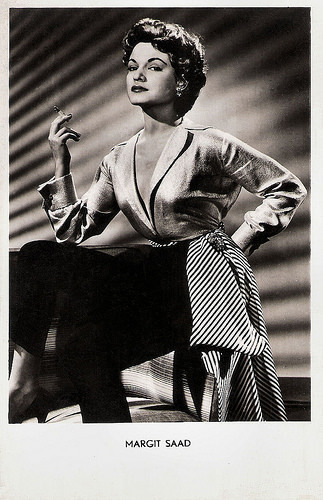
Vintage postcard, no. 103.
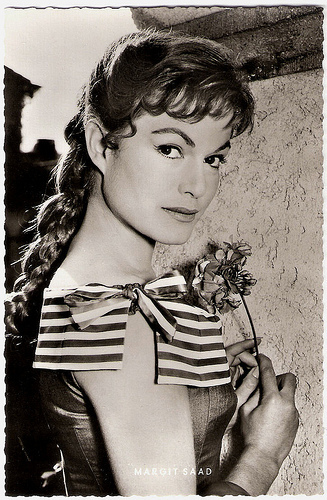
German postcard by Kunst und Bild, Berlin-Charlottenburg, no. T 864. Photo: Bavaria / Schorcht / Vogelmann. Publicity still for Ein Stück vom Himmel/A Piece of Heaven (Rudolf Jugert, 1958).
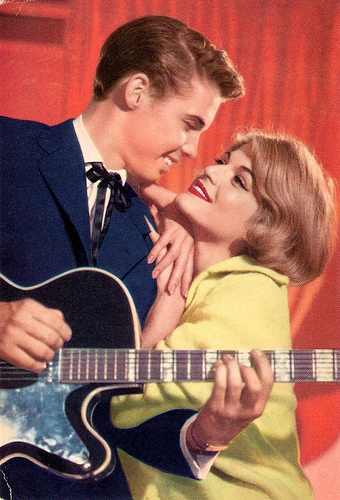
German postcard by ISV, no. H 43. Peter Kraus and Margit Saad in Melodie und Rhythmus/Melody and Rhythms (John Olden, 1959).
Daughter of a Lebanese language professor
Margit Daisy Saad was born in Munich, Bavaria in 1929. She is the daughter of the Lebanese language professor Fuad Jabbour Saad and German language teacher Agnes Saad, born Diepgen.
Margit studied acting at the Otto-Falckenberg-Schule in Munich. To finance her studies, she worked as a model. She had her first stage engagement in Düsseldorf.
Saad made her screen debut in the Austrian comedy Eva erbt das Paradies... ein Abenteuer im Salzkammergut/Eva Inherits Paradise (Franz Antel, 1951), starring Maria Andergast. She also appeared as a nun in the West German drama Hinter Klostermauern/The Unholy Intruders (Harald Reinl, 1952) starring Olga Tschechowa , Frits van Dongen (a.k.a. Philip Dorn) and Katharina Mayberg.
She played leading roles in the romantic musical Südliche Nächte/Southern Nights (Robert A. Stemmle, 1953), the operetta Baron Tzigane/Gypsy Baron (Arthur Maria Rabenalt, 1954) with Georges Guétary , and the romantic comedy Drei Mädels vom Rhein/Three girls from the Rhine (Ernst Jacoby, 1955).
In the Swedish-German coproduction Sommarflickan/Swedish Girl (Håkan Bergström, Thomas Engel, 1955), she had a part opposite Maj-Britt Nilsson and . Karlheinz Böhm A popular success was the West German crime-comedy Peter Voss, der Millionendieb/Peter Voss, Thief of Millions (Wolfgang Becker, 1958) featuring O.W. Fischer . It was based on the 1913 novel Peter Voss, Thief of Millions by Ewald Gerhard Seeliger, which had been previously adapted into three films.
In France, she appeared in Les dragueurs/The Dredgers (Jean-Pierre Mocky, 1959). Other films that year were Heiße Ware/Hot goods (Paul May, 1959) with Ivan Desny , and the teen musical Melodie und Rhythmus/Melody and Rhythms (John Olden, 1959) with teen idol Peter Kraus .
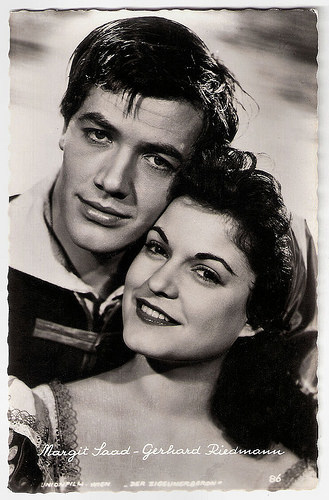
Austrian postcard by Verlag Hubmann, Wien, no.3837. Photo: Unionfilm, Wien. Publicity still for Der Zigeunerbaron/The Gypsy Baron (Arthur Maria Rabenalt, 1954) with Gerhard Riedmann .
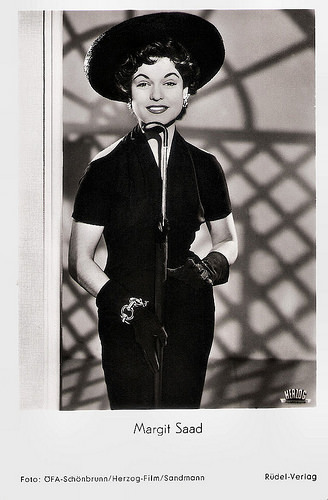
German postcard by Rüdel-Verlag, Hamburg-Bergedorfno. 1265. Photo: ÖFA / Schönbrunn / Herzog-Film / Sandmann. Publicity still for Ehesanatorium/That's Love (Franz Antel, 1955).
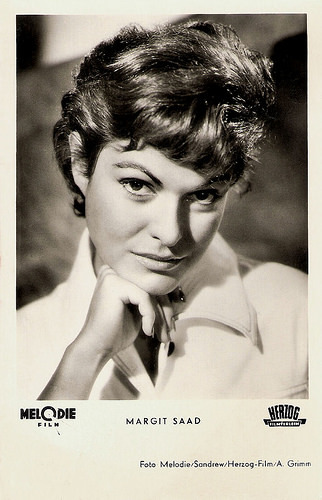
German postcard by Kunst und Bild, Berlin-Charlottenburg, no. I 436. Photo: Melodie / Sandrew / Herzog-Film / Arthur Grimm. Publicity still for Sommarflickan/Swedish Girl (Håkan Bergström, Thomas Engel, 1955).
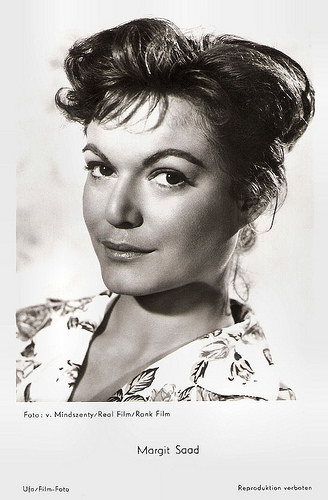
German postcard by Ufa, Berlin-Tempelhof, no. FK 3302. Photo: v. Mindszenty / Real-Film / Rank Film. Publicity still for Drei Birken auf der Heide/Three birches on the heath (Ulrich Erfurth, 1956).
The film's seedy milieu and sadistic streak
In 1960 Margit Saad starred in the British drama The Criminal (Joseph Losey, 1960) with Stanley Baker and Sam Wanamaker.
Mario Gauci at IMDb : “While essentially character-driven, the film's seedy milieu and sadistic streak allows for a number of vivid sequences (though the race-track robbery itself is rather thrown away!) including the wild party held at Baker's flat on being released from prison (highlighting sexy Margit Saad who subsequently replaces Jill Bennett as Baker's moll), the equally chaotic prison riot, Baker's escape from the penitentiary (having been betrayed after the robbery and recaptured) and the inevitable showdown with the ruthless Wanamaker.”
She followed it up with appearances in other British films such as The Rebel (Robert Day, 1961) with Tony Hancock and George Sanders, and the low budget thriller Playback (Quentin Lawrence, 1962). The latter was one of a series of British films based on Edgar Wallace novels, released between 1960 and 1965.
On TV she appeared opposite Roger Moore in an episode of The Saint, The Saint Sees It Through (Robert S. Baker, 1964). And in the cinema, she supported TV comedians Eric Morecambe and Ernie Wise in The Magnificent Two (Cliff Owen, 1967).
In Germany, she co-starred with Stewart Granger in the Edgar Wallace crime film Das Geheimnis der drei Dschunken/Code Name Alpha (Ernst Hofbauer, 1965).
In 1966, Saad appeared in an episode of the American television espionage series Blue Light, starring Robert Goulet and Christine Carère. It was edited together with three other episodes into the feature film I Deal in Danger (Walter Grauman, 1966), which includes her appearance.
Later she also appeared in Grauman’s war film The Last Escape (Walter Grauman, 1969) starring Stuart Whitman. It was her last film, but she continued to appear incidentally on German TV.
Saad also started to direct TV films, including the drama Die Geschichte vom guten alten Herrn und dem schonen Madchen/The story of the good old gentleman and the beautiful girl (1986) with Peter Pasetti .
From 1957 till his death in 1988, Margit Saad was married to noted French opera director Jean-Pierre Ponnelle. They had one son, conductor Pierre-Dominique Ponnelle.
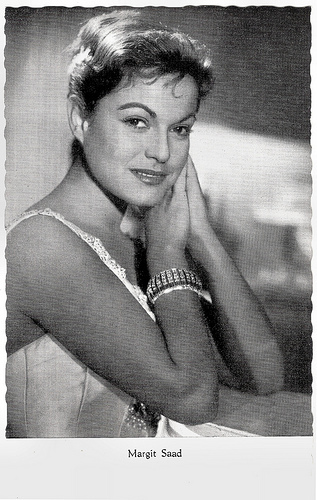
German postcard by Kolibri-Verlag, Minden/Westf., no. D 40. Photo: Berolina / Constantin / Wesel. Publicity still for Was die Schwalbe sang/What the swallow sang (Géza von Bolváry, 1956).
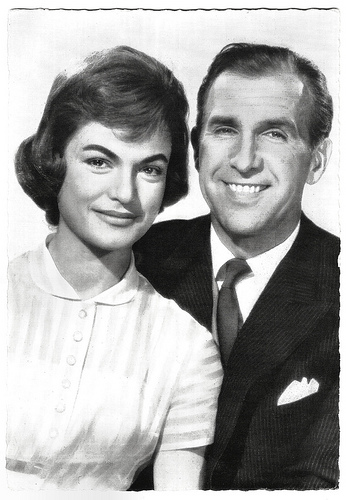
German postcard by WS-Druck, Wanne-Eickel, no. 309. Photo: Unionfilm / Wanka. Publicity still for Ein Amerikaner in Salzburg/An American in Salzburg (Helmut Weiss, 1958) with Bruce Low.
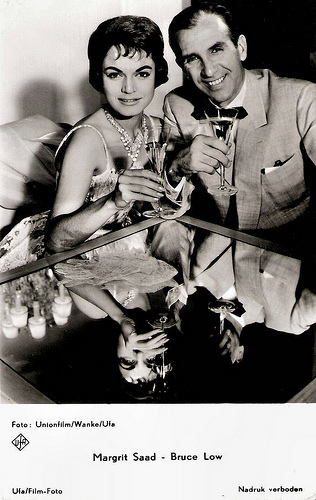
Dutch postcard by Gebr. Spanjersberg N.V., Rotterdam no. 1488. Photo: Unionfilm / Wanke / Ufa. Publicity still for Ein Amerikaner in Salzburg/An American in Salzburg (Helmut Weiss, 1958) with Bruce Low.
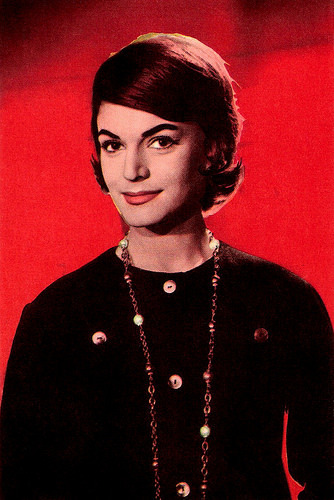
Belgian postcard by Cox, no. 48.
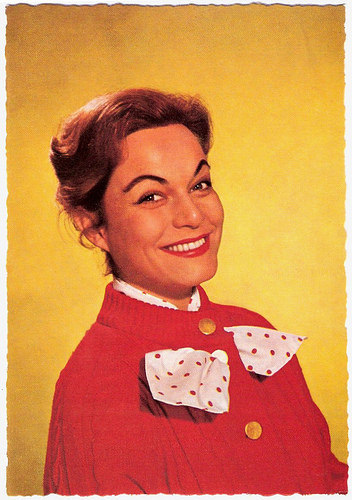
German postcard by WS-Druck, Wanne Eickel, no. F 101. Photo: Klaus Collignon.
Sources: Mario Gauci (IMDb), British Film Institute, Wikipedia (English and German) and .

German postcard by Rüdel-Verlag, Hamburg-Bergedorf, no. 844. Photo: ÖFA-Schönbrun / Herzog-Film / Czerwonski. Publicity still for Hab ich nur deine Diebe/I only have your love (Eduard von Borsody, 1953).

German postcard by Kunst und Bild, Berlin, no. A 1128. Photo: Herzog / Berolina. Publicity still for Der Zigeunerbaron/Baron Tzigane/Gypsy Baron (Arthur Maria Rabenalt, 1954).

Vintage postcard, no. 103.

German postcard by Kunst und Bild, Berlin-Charlottenburg, no. T 864. Photo: Bavaria / Schorcht / Vogelmann. Publicity still for Ein Stück vom Himmel/A Piece of Heaven (Rudolf Jugert, 1958).

German postcard by ISV, no. H 43. Peter Kraus and Margit Saad in Melodie und Rhythmus/Melody and Rhythms (John Olden, 1959).
Daughter of a Lebanese language professor
Margit Daisy Saad was born in Munich, Bavaria in 1929. She is the daughter of the Lebanese language professor Fuad Jabbour Saad and German language teacher Agnes Saad, born Diepgen.
Margit studied acting at the Otto-Falckenberg-Schule in Munich. To finance her studies, she worked as a model. She had her first stage engagement in Düsseldorf.
Saad made her screen debut in the Austrian comedy Eva erbt das Paradies... ein Abenteuer im Salzkammergut/Eva Inherits Paradise (Franz Antel, 1951), starring Maria Andergast. She also appeared as a nun in the West German drama Hinter Klostermauern/The Unholy Intruders (Harald Reinl, 1952) starring Olga Tschechowa , Frits van Dongen (a.k.a. Philip Dorn) and Katharina Mayberg.
She played leading roles in the romantic musical Südliche Nächte/Southern Nights (Robert A. Stemmle, 1953), the operetta Baron Tzigane/Gypsy Baron (Arthur Maria Rabenalt, 1954) with Georges Guétary , and the romantic comedy Drei Mädels vom Rhein/Three girls from the Rhine (Ernst Jacoby, 1955).
In the Swedish-German coproduction Sommarflickan/Swedish Girl (Håkan Bergström, Thomas Engel, 1955), she had a part opposite Maj-Britt Nilsson and . Karlheinz Böhm A popular success was the West German crime-comedy Peter Voss, der Millionendieb/Peter Voss, Thief of Millions (Wolfgang Becker, 1958) featuring O.W. Fischer . It was based on the 1913 novel Peter Voss, Thief of Millions by Ewald Gerhard Seeliger, which had been previously adapted into three films.
In France, she appeared in Les dragueurs/The Dredgers (Jean-Pierre Mocky, 1959). Other films that year were Heiße Ware/Hot goods (Paul May, 1959) with Ivan Desny , and the teen musical Melodie und Rhythmus/Melody and Rhythms (John Olden, 1959) with teen idol Peter Kraus .

Austrian postcard by Verlag Hubmann, Wien, no.3837. Photo: Unionfilm, Wien. Publicity still for Der Zigeunerbaron/The Gypsy Baron (Arthur Maria Rabenalt, 1954) with Gerhard Riedmann .

German postcard by Rüdel-Verlag, Hamburg-Bergedorfno. 1265. Photo: ÖFA / Schönbrunn / Herzog-Film / Sandmann. Publicity still for Ehesanatorium/That's Love (Franz Antel, 1955).

German postcard by Kunst und Bild, Berlin-Charlottenburg, no. I 436. Photo: Melodie / Sandrew / Herzog-Film / Arthur Grimm. Publicity still for Sommarflickan/Swedish Girl (Håkan Bergström, Thomas Engel, 1955).

German postcard by Ufa, Berlin-Tempelhof, no. FK 3302. Photo: v. Mindszenty / Real-Film / Rank Film. Publicity still for Drei Birken auf der Heide/Three birches on the heath (Ulrich Erfurth, 1956).
The film's seedy milieu and sadistic streak
In 1960 Margit Saad starred in the British drama The Criminal (Joseph Losey, 1960) with Stanley Baker and Sam Wanamaker.
Mario Gauci at IMDb : “While essentially character-driven, the film's seedy milieu and sadistic streak allows for a number of vivid sequences (though the race-track robbery itself is rather thrown away!) including the wild party held at Baker's flat on being released from prison (highlighting sexy Margit Saad who subsequently replaces Jill Bennett as Baker's moll), the equally chaotic prison riot, Baker's escape from the penitentiary (having been betrayed after the robbery and recaptured) and the inevitable showdown with the ruthless Wanamaker.”
She followed it up with appearances in other British films such as The Rebel (Robert Day, 1961) with Tony Hancock and George Sanders, and the low budget thriller Playback (Quentin Lawrence, 1962). The latter was one of a series of British films based on Edgar Wallace novels, released between 1960 and 1965.
On TV she appeared opposite Roger Moore in an episode of The Saint, The Saint Sees It Through (Robert S. Baker, 1964). And in the cinema, she supported TV comedians Eric Morecambe and Ernie Wise in The Magnificent Two (Cliff Owen, 1967).
In Germany, she co-starred with Stewart Granger in the Edgar Wallace crime film Das Geheimnis der drei Dschunken/Code Name Alpha (Ernst Hofbauer, 1965).
In 1966, Saad appeared in an episode of the American television espionage series Blue Light, starring Robert Goulet and Christine Carère. It was edited together with three other episodes into the feature film I Deal in Danger (Walter Grauman, 1966), which includes her appearance.
Later she also appeared in Grauman’s war film The Last Escape (Walter Grauman, 1969) starring Stuart Whitman. It was her last film, but she continued to appear incidentally on German TV.
Saad also started to direct TV films, including the drama Die Geschichte vom guten alten Herrn und dem schonen Madchen/The story of the good old gentleman and the beautiful girl (1986) with Peter Pasetti .
From 1957 till his death in 1988, Margit Saad was married to noted French opera director Jean-Pierre Ponnelle. They had one son, conductor Pierre-Dominique Ponnelle.

German postcard by Kolibri-Verlag, Minden/Westf., no. D 40. Photo: Berolina / Constantin / Wesel. Publicity still for Was die Schwalbe sang/What the swallow sang (Géza von Bolváry, 1956).

German postcard by WS-Druck, Wanne-Eickel, no. 309. Photo: Unionfilm / Wanka. Publicity still for Ein Amerikaner in Salzburg/An American in Salzburg (Helmut Weiss, 1958) with Bruce Low.

Dutch postcard by Gebr. Spanjersberg N.V., Rotterdam no. 1488. Photo: Unionfilm / Wanke / Ufa. Publicity still for Ein Amerikaner in Salzburg/An American in Salzburg (Helmut Weiss, 1958) with Bruce Low.

Belgian postcard by Cox, no. 48.

German postcard by WS-Druck, Wanne Eickel, no. F 101. Photo: Klaus Collignon.
Sources: Mario Gauci (IMDb), British Film Institute, Wikipedia (English and German) and .
Published on July 08, 2017 22:00
July 7, 2017
Otto Gebühr
German actor Otto Gebühr (1877-1954) appeared in 102 films between 1917 and 1962. He is best known for his interpretation of Friedrich II (Frederick the Great), a role he played in 16 films and countless stage performances. He was one the most famous actors of the Weimar period, and thanks to his authoritative roles the Nazis gave him the title 'Actor of the State'.
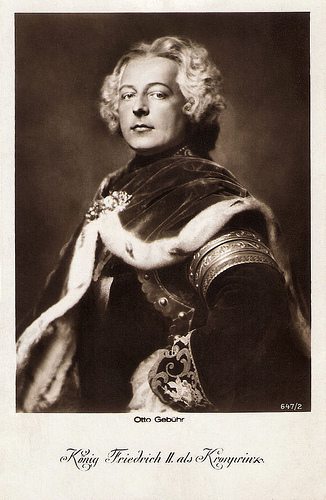
German postcard by W.J. Morlins / Ross Verlag, no. 647/2. Photo: Karl Schenker. Publicity still for Fridericus Rex (Arzén von Cserépy, 1921). Fridericus Rex was a four-part series with Otto Gebühr as King Frederick II as Crown Prince in part I and II.
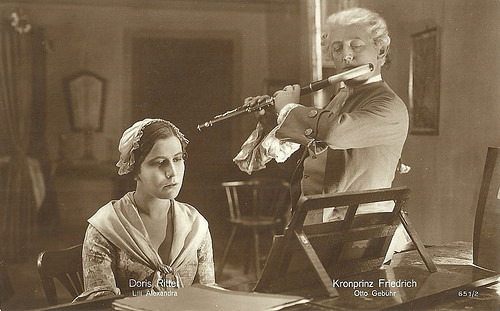
German postcard by Ross Verlag, no. 651/2. Otto Gebühr as crown prince Frederick (future Frederick II) and Lilly Alexander as Doris Ritter in Fridericus Rex (Arzen von Cserépy, 1921-1922).
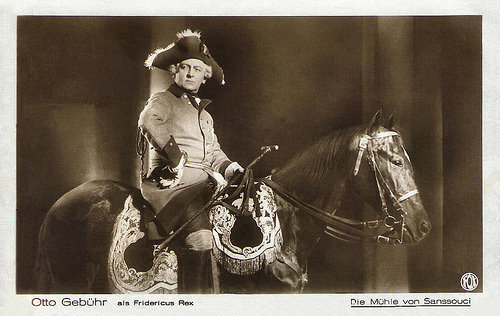
German postcard by Ross Verlag. Photo: Fox. Otto Gebühr as King Frederick the Great in the German silent film Die Mühle von Sanssouci/The Mill of Sanssouci (Friedrich Zelnik, Siegfried Philippi, 1926).
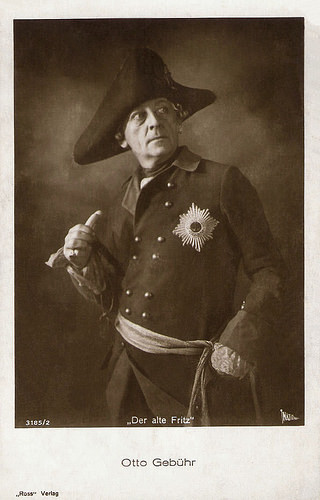
German postcard by Ross Verlag, no. 3185/2, 1928-1929. Photo: National. Publicity still for Der alte Fritz/The Old Fritz (Gerhard Lamprecht, 1928).
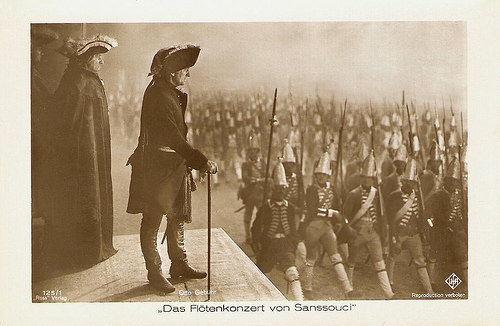
German postcard by Ross Verlag, no. 125/1. Photo: Ufa. Otto Gebühr as Frederick the Great in Das Flötenkonzert von Sanssouci/The Flute Concert of Sans-Souci (Gustav Ucicky, 1930).
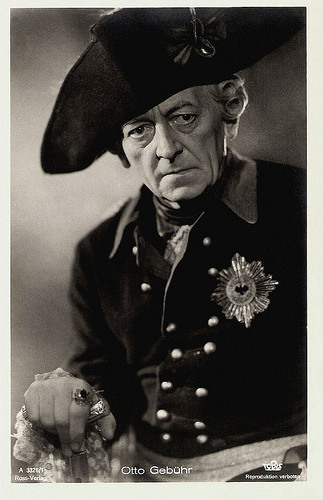
German postcard by Ross Verlag, no. A 3326/1, 1931-1944. Photo: Tobis. Publicity still for Der große König/The Great King (Veit Harlan, 1942).
The king of Prussia
Otto Gebühr was born in Kettwig (now Essen), Germany in 1877. He was the son of merchant Otto Gebühr and his wife Fanny Mathilde Moll. He grew up in Hülsenbusch, a part of Gummersbach, and, after his father’s death, in Köln (Cologne).
After attending grammar school he had a trade training at a wool firm. In 1896 he worked as a correspondent in foreign languages for a firm in Berlin, but he also had acting classes. For a while he then worked as a strolling actor till he got a contract at the Stadttheater Görlitz.
From 1898 till 1908 he worked at the Königlichen Hoftheater in Dresden, and till 1914 at the Lessingtheater and the Theater in der Königgrätzer Straße, both in Berlin. During the First World War he was an army volunteer for the field artillery regiment and became a second lieutenant. After this he worked from 1917 till 1919 for famous director Max Reinhardt at the Deutschen Theater in Berlin.
At the same time he began to appear in silent films. His film debut was Der Richter/The Judge (Hans Land, 1917) for the Messter company. Gebühr was a look-a-like of king Friedrich II (1712-1786). Introduced by his colleague Paul Wegener , director Carl Boese cast him as the king of Prussia in the silent film Die Tänzerin Barberina/The Dancer Barbarina (Carl Boese, 1920). The role would become his breakthrough. He would play Friedrich several times, but initially in the very successful, four-part-film-series Fridericus Rex (1920-1923).
To his other well-known silent films belong the crime film Whitechapel (Ewald André Dupont, 1920), the worldwide success Der Golem, wie er in die Welt kam/The Golem: How He Came Into the World (Carl Boese, Paul Wegener, 1920, Wilhelm Tell (Rudolf Dworsky, Rudolf Walther-Fein, 1923, Die Perücke/The Wig (Berthold Viertel, 1925), Die Gesunkenen/The Sunken (Rudolf Walther-Fein, Rudolf Dworsky, 1925), and Waterloo (Karl Grune, 1929).
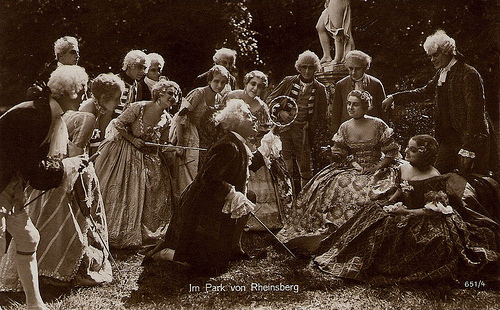
German postcard by Ross Verlag, Berlin, no. 651/4, sent by mail in 1922. Photo: Cserépy-Film Co. Still for Fridericus Rex (1921).
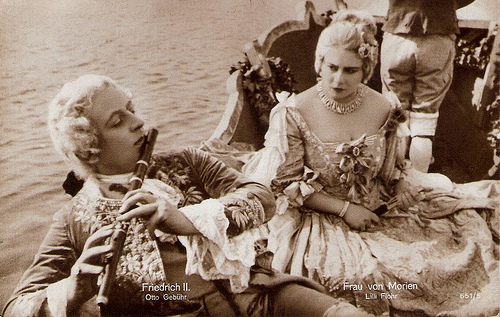
German postcard by Ross Verlag, Berlin, no. 651/8, sent by mail in 1922. Photo: Cserépy-Film Co. Still for Fridericus Rex (1922) with Lili Flohr .
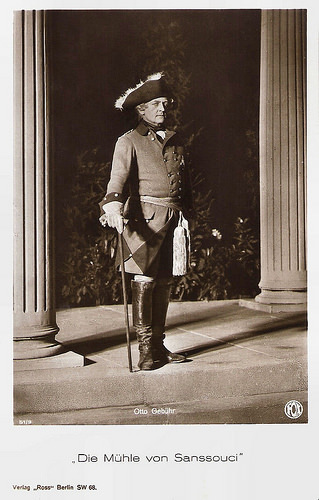
German postcard by Ross Verlag, no. 51/9. Photo: Fox. Otto Gebühr as King Frederick the Great in the German silent film Die Mühle von Sanssouci/The Mill of Sanssouci (Friedrich Zelnik, Siegfried Philippi, 1926).
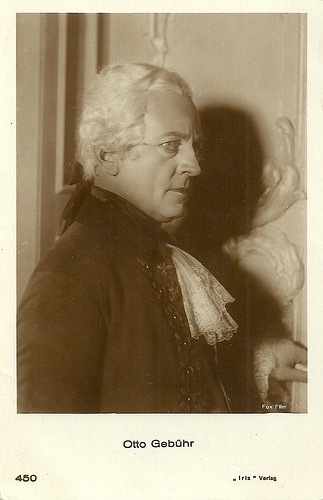
Austrian postcard by Iris Verlag, no. 450. Photo: Fox Film.
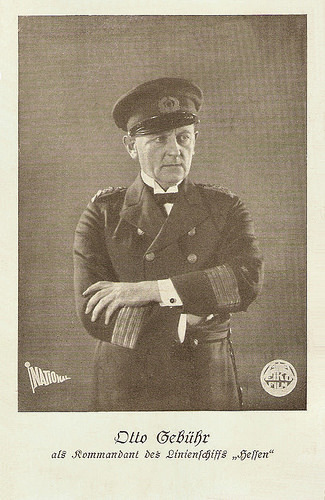
German postcard by Eiko Film / National-Film A.G., Berlin. Photo: Eiko Film / National. Publicity still for In treue stark/In faithful strong (Heinrich Brandt, 1926). Caption: Otto Gebúhr as commander of the Line Ship Heffen.
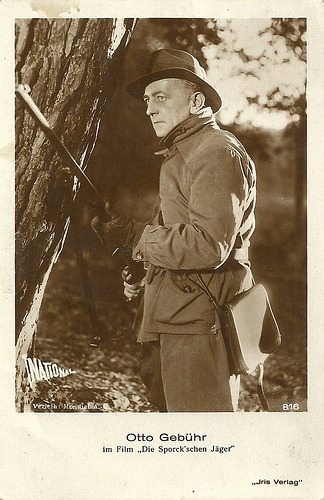
Austrian postcard by Iris Verlag, no. 816. Photo: National Film / Mondial AG. Otto Gebühr in the German silent film Die Sporck'schen Jäger (Holger-Madsen, 1926).
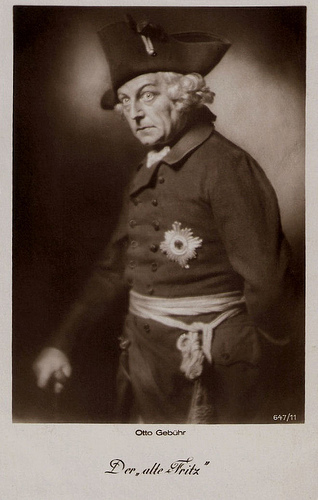
German postcard by W.J. Morlins, Berlin / Ross Verlag, Berlin, no. 647/11. Photo: Karl Schenker / Cserépy-Film Co. Still for Der Alte Fritz/The Old Fritz (Gerhard Lamprecht, 1928) with Otto Gebühr as Friedrich II.
First National Socialist
After the introduction of the sound film, Otto Gebühr again had a huge success as the king of Prussia in Das Flötenkonzert in Sanssouci/The Flute Concert of Sans-Souci (Gustav Ucicky, 1930). He repeated his role in the remake of Die Tänzerin von Sanssouci/Barberina (Friedrich Zelnik, 1932) at the side of Lil Dagover and Hans Stüwe .
Gebühr was the cinematic incarnation of the heroic Prussian, and his type was popular during the Third Reich. Gebühr was a voluntarily pawn in the propaganda machine of the Nazis and appeared in several films, including Fridericus (Johannes Meyer, 1937) with Lil Dagover , as the ‘First National Socialist’, like propaganda minister Joseph Goebbels had called him.
In 1938 he gave Gebühr the title 'Staatsschauspieler' (Actor of the State). He was then one of the four highest paid and most famous actors of Germany - the others were Heinz Rühmann , Hans Albers and Heinrich George .
Among his entertainment films were big hits as Der Choral von Leuthen/The Anthem of Leuthen (Carl Froelich, Arzén von Cserépy, 1933) with Olga Tschechova , Nanon (Herbert Maisch, 1938) with Johannes Heesters , and Casanova heiratet/Casanova Marries (Viktor de Kowa, 1939).
Some of his roles, like Blücher in Waterloo (Karl Grune, 1928) and the king of Saxony in Bismarck (Wolfgang Liebeneiner, 1940), had the same authoritative features as Friedrich II. He again appeared as Friedrich II in Veit Harlan ’s epic Der große König/The Great King (Veit Harlan, 1942).
Till the end of the Third Reich he appeared in more light entertainment films like Immensee (Veit Harlan, 1943) starring Kristina Söderbaum and Carl Raddatz , Die goldene Spinne/The Golden Spider (Erich Engels, 1943), and Der Erbförster/The Hereditary Forester (Alois Johannes Lippl, 1945).
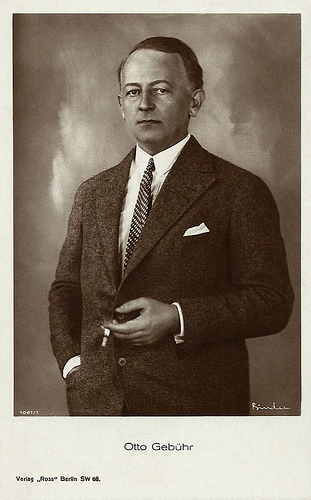
German postcard by Ross Verlag, no. 1067/1, 1927-1928. Photo Alex Binder.
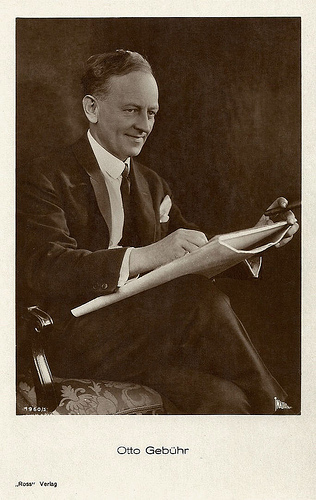
German postcard by Ross Verlag, no. 1960/1, 1927-1928. Photo: National.
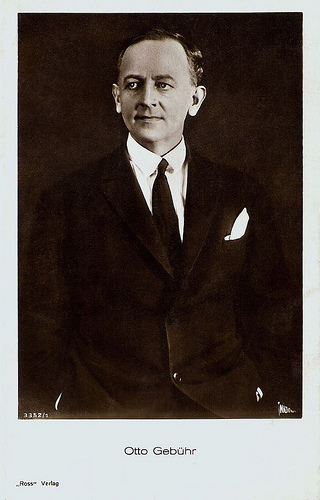
German postcard by Ross Verlag, no. 3352/1, 1928-1929. Photo: National.
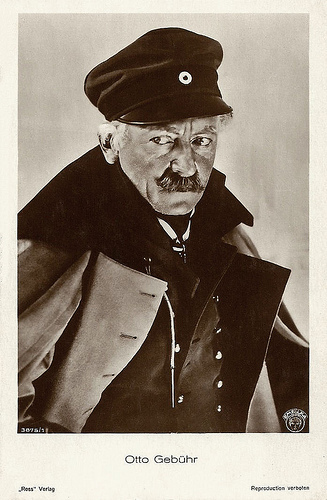
German postcard by Ross Verlag, no. 3875/1, 1928-1929. Photo: Emelka. Publicity still for Waterloo (Karl Grune, 1928), in which Gebühr played General/Fieldmarshall Blücher and Frederick the Great. Here he is dressed as Blücher.
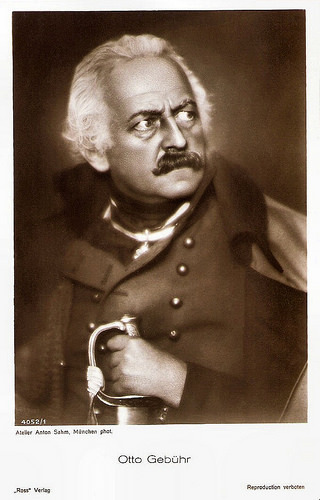
German postcard by Ross Verlag, no. 4052/1, 1929-1930. Photo: Anton Sahm, München.
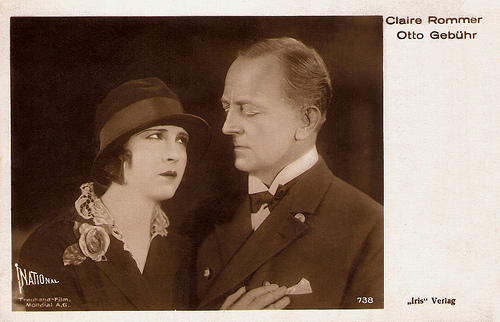
Austrian postcard by Iris Verlag, no. 738. Photo: Treuhand-Film / Mondial A.G. / National. Publicity still for Scapa Flow (Leo Lasko, 1930) with Claire Rommer .
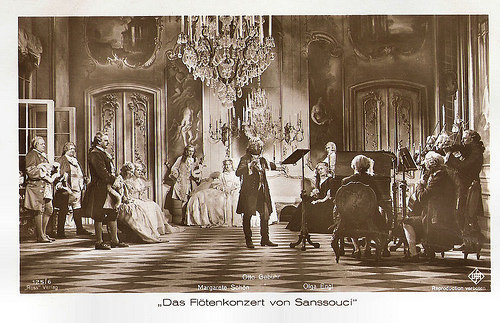
German postcard by Ross Verlag, no. 125/6. Photo: Ufa. Otto Gebühr as Frederick the Great in Das Flötenkonzert von Sanssouci/The Flute Concert of Sans-Souci (Gustav Ucicky, 1930). This picture is a literal citation of the famous painting Flötenkonzert Friedrichs des Großen in Sanssouci (1850-52) by Adolph (von) Menzel, now at the Alte Nationalgalerie in Berlin.
Heimatfilms
From 1947 on Otto Gebühr was permitted to work again in the theatre. His first post-war film was the drama ...und über uns der Himmel/...and the Sky Above Us (Josef von Báky, 1947) starring Hans Albers .
Till his death he appeared in many entertainment films. He often played the odd companion or the cheerful senile maverick in such Heimatfilms as Melodie des Schicksals/Melody of Destiny (Hans Schweikart, 1950) with Brigitte Horney , and Grün ist die Heide/The Heath Is Green (Hans Deppe, 1951) starring Sonja Ziemann and Rudolf Prack .
Again he also appeared under the direction of Veit Harlan in Unsterbliche Geliebte/Immortal Beloved (1951) with Kristina Söderbaum .
His final film was Die Blonde Frau des Maharadscha/The Blonde Wife of the Maharadja (Veit Harlan, 1962) – a new version of Die Gefangene des Maharadscha/Circus Girl (Veit Harlan, 1954). The film was released eight years after his death.
Otto Gebühr died of a heart failure in 1954, in Wiesbaden, Germany. He was twice married. In 1910 he had married Cornelia Bertha Julius, with whom he had a daughter, actress Hilde Gebühr. His second wife was actress Doris Krüger, with whom he was married from 1942 till her death in 1950. They had a son, Prof. Dr. Michael Gebühr.
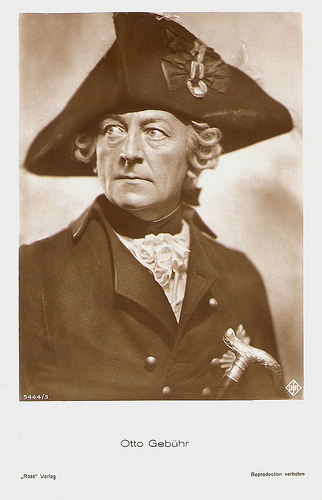
German postcard by Ross Verlag, no. 5444/3, 1930-1931. Photo: Ufa. Publicity still for Das Flötenkonzert von Sanssouci (Gustav von Ucicky, 1930) again with Otto Gebühr as Friedrich II.
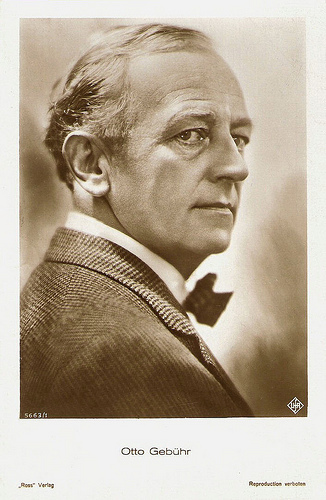
German postcard by Ross Verlag, Berlin, no. 5663/11, 1930-1931. Photo: Ufa.
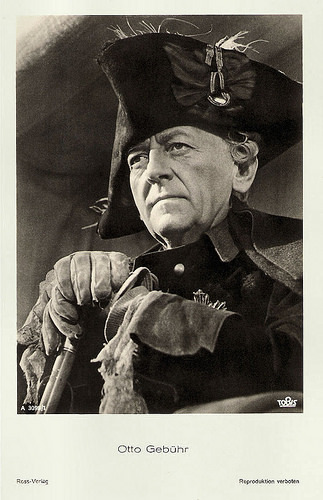
German postcard by Ross Verlag, no. A 3098/1, 1941-1944. Photo: Tobis.
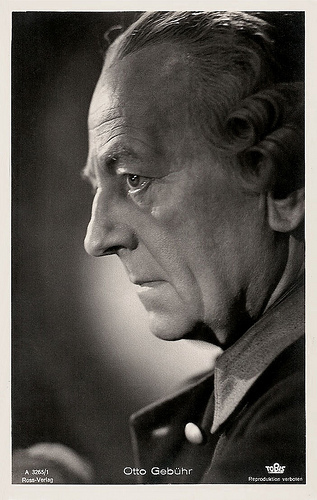
German postcard by Ross Verlag, no. A 3265/1, 1941-1944. Photo: Tobis.
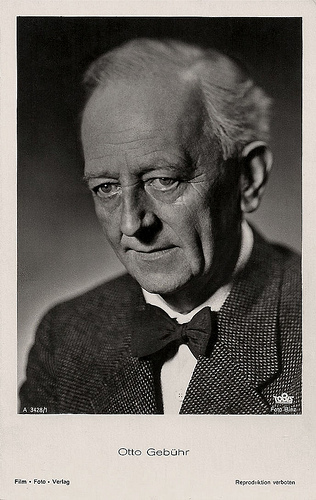
German postcard by Film-Foto-Verlag, no. A 3428/1, 1941-1944. Photo: Binz / Tobis.
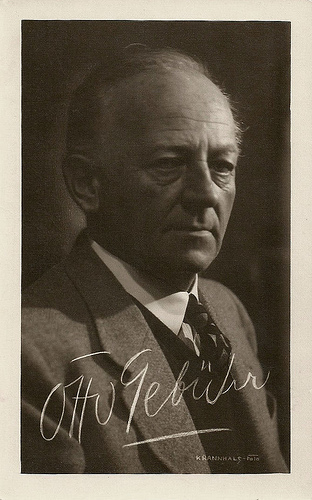
German postcard. Photo: Krannhals.
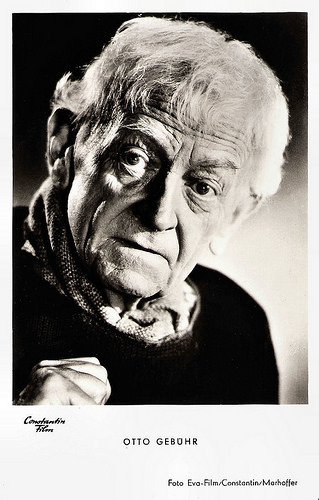
German postcard by Kunst und Bild, Berlin, no. A 1098. Photo: Eva-Film / Constantin / Marhoffer. Publicity still for Rosen-Resli/Rose-Girl Resli (Harald Reinl, 1954).
Sources: Thomas Staedeli (Cyranos), Wikipedia (German), Deutsches Historisches Museum (German), and .

German postcard by W.J. Morlins / Ross Verlag, no. 647/2. Photo: Karl Schenker. Publicity still for Fridericus Rex (Arzén von Cserépy, 1921). Fridericus Rex was a four-part series with Otto Gebühr as King Frederick II as Crown Prince in part I and II.

German postcard by Ross Verlag, no. 651/2. Otto Gebühr as crown prince Frederick (future Frederick II) and Lilly Alexander as Doris Ritter in Fridericus Rex (Arzen von Cserépy, 1921-1922).

German postcard by Ross Verlag. Photo: Fox. Otto Gebühr as King Frederick the Great in the German silent film Die Mühle von Sanssouci/The Mill of Sanssouci (Friedrich Zelnik, Siegfried Philippi, 1926).

German postcard by Ross Verlag, no. 3185/2, 1928-1929. Photo: National. Publicity still for Der alte Fritz/The Old Fritz (Gerhard Lamprecht, 1928).

German postcard by Ross Verlag, no. 125/1. Photo: Ufa. Otto Gebühr as Frederick the Great in Das Flötenkonzert von Sanssouci/The Flute Concert of Sans-Souci (Gustav Ucicky, 1930).

German postcard by Ross Verlag, no. A 3326/1, 1931-1944. Photo: Tobis. Publicity still for Der große König/The Great King (Veit Harlan, 1942).
The king of Prussia
Otto Gebühr was born in Kettwig (now Essen), Germany in 1877. He was the son of merchant Otto Gebühr and his wife Fanny Mathilde Moll. He grew up in Hülsenbusch, a part of Gummersbach, and, after his father’s death, in Köln (Cologne).
After attending grammar school he had a trade training at a wool firm. In 1896 he worked as a correspondent in foreign languages for a firm in Berlin, but he also had acting classes. For a while he then worked as a strolling actor till he got a contract at the Stadttheater Görlitz.
From 1898 till 1908 he worked at the Königlichen Hoftheater in Dresden, and till 1914 at the Lessingtheater and the Theater in der Königgrätzer Straße, both in Berlin. During the First World War he was an army volunteer for the field artillery regiment and became a second lieutenant. After this he worked from 1917 till 1919 for famous director Max Reinhardt at the Deutschen Theater in Berlin.
At the same time he began to appear in silent films. His film debut was Der Richter/The Judge (Hans Land, 1917) for the Messter company. Gebühr was a look-a-like of king Friedrich II (1712-1786). Introduced by his colleague Paul Wegener , director Carl Boese cast him as the king of Prussia in the silent film Die Tänzerin Barberina/The Dancer Barbarina (Carl Boese, 1920). The role would become his breakthrough. He would play Friedrich several times, but initially in the very successful, four-part-film-series Fridericus Rex (1920-1923).
To his other well-known silent films belong the crime film Whitechapel (Ewald André Dupont, 1920), the worldwide success Der Golem, wie er in die Welt kam/The Golem: How He Came Into the World (Carl Boese, Paul Wegener, 1920, Wilhelm Tell (Rudolf Dworsky, Rudolf Walther-Fein, 1923, Die Perücke/The Wig (Berthold Viertel, 1925), Die Gesunkenen/The Sunken (Rudolf Walther-Fein, Rudolf Dworsky, 1925), and Waterloo (Karl Grune, 1929).

German postcard by Ross Verlag, Berlin, no. 651/4, sent by mail in 1922. Photo: Cserépy-Film Co. Still for Fridericus Rex (1921).

German postcard by Ross Verlag, Berlin, no. 651/8, sent by mail in 1922. Photo: Cserépy-Film Co. Still for Fridericus Rex (1922) with Lili Flohr .

German postcard by Ross Verlag, no. 51/9. Photo: Fox. Otto Gebühr as King Frederick the Great in the German silent film Die Mühle von Sanssouci/The Mill of Sanssouci (Friedrich Zelnik, Siegfried Philippi, 1926).

Austrian postcard by Iris Verlag, no. 450. Photo: Fox Film.

German postcard by Eiko Film / National-Film A.G., Berlin. Photo: Eiko Film / National. Publicity still for In treue stark/In faithful strong (Heinrich Brandt, 1926). Caption: Otto Gebúhr as commander of the Line Ship Heffen.

Austrian postcard by Iris Verlag, no. 816. Photo: National Film / Mondial AG. Otto Gebühr in the German silent film Die Sporck'schen Jäger (Holger-Madsen, 1926).

German postcard by W.J. Morlins, Berlin / Ross Verlag, Berlin, no. 647/11. Photo: Karl Schenker / Cserépy-Film Co. Still for Der Alte Fritz/The Old Fritz (Gerhard Lamprecht, 1928) with Otto Gebühr as Friedrich II.
First National Socialist
After the introduction of the sound film, Otto Gebühr again had a huge success as the king of Prussia in Das Flötenkonzert in Sanssouci/The Flute Concert of Sans-Souci (Gustav Ucicky, 1930). He repeated his role in the remake of Die Tänzerin von Sanssouci/Barberina (Friedrich Zelnik, 1932) at the side of Lil Dagover and Hans Stüwe .
Gebühr was the cinematic incarnation of the heroic Prussian, and his type was popular during the Third Reich. Gebühr was a voluntarily pawn in the propaganda machine of the Nazis and appeared in several films, including Fridericus (Johannes Meyer, 1937) with Lil Dagover , as the ‘First National Socialist’, like propaganda minister Joseph Goebbels had called him.
In 1938 he gave Gebühr the title 'Staatsschauspieler' (Actor of the State). He was then one of the four highest paid and most famous actors of Germany - the others were Heinz Rühmann , Hans Albers and Heinrich George .
Among his entertainment films were big hits as Der Choral von Leuthen/The Anthem of Leuthen (Carl Froelich, Arzén von Cserépy, 1933) with Olga Tschechova , Nanon (Herbert Maisch, 1938) with Johannes Heesters , and Casanova heiratet/Casanova Marries (Viktor de Kowa, 1939).
Some of his roles, like Blücher in Waterloo (Karl Grune, 1928) and the king of Saxony in Bismarck (Wolfgang Liebeneiner, 1940), had the same authoritative features as Friedrich II. He again appeared as Friedrich II in Veit Harlan ’s epic Der große König/The Great King (Veit Harlan, 1942).
Till the end of the Third Reich he appeared in more light entertainment films like Immensee (Veit Harlan, 1943) starring Kristina Söderbaum and Carl Raddatz , Die goldene Spinne/The Golden Spider (Erich Engels, 1943), and Der Erbförster/The Hereditary Forester (Alois Johannes Lippl, 1945).

German postcard by Ross Verlag, no. 1067/1, 1927-1928. Photo Alex Binder.

German postcard by Ross Verlag, no. 1960/1, 1927-1928. Photo: National.

German postcard by Ross Verlag, no. 3352/1, 1928-1929. Photo: National.

German postcard by Ross Verlag, no. 3875/1, 1928-1929. Photo: Emelka. Publicity still for Waterloo (Karl Grune, 1928), in which Gebühr played General/Fieldmarshall Blücher and Frederick the Great. Here he is dressed as Blücher.

German postcard by Ross Verlag, no. 4052/1, 1929-1930. Photo: Anton Sahm, München.

Austrian postcard by Iris Verlag, no. 738. Photo: Treuhand-Film / Mondial A.G. / National. Publicity still for Scapa Flow (Leo Lasko, 1930) with Claire Rommer .

German postcard by Ross Verlag, no. 125/6. Photo: Ufa. Otto Gebühr as Frederick the Great in Das Flötenkonzert von Sanssouci/The Flute Concert of Sans-Souci (Gustav Ucicky, 1930). This picture is a literal citation of the famous painting Flötenkonzert Friedrichs des Großen in Sanssouci (1850-52) by Adolph (von) Menzel, now at the Alte Nationalgalerie in Berlin.
Heimatfilms
From 1947 on Otto Gebühr was permitted to work again in the theatre. His first post-war film was the drama ...und über uns der Himmel/...and the Sky Above Us (Josef von Báky, 1947) starring Hans Albers .
Till his death he appeared in many entertainment films. He often played the odd companion or the cheerful senile maverick in such Heimatfilms as Melodie des Schicksals/Melody of Destiny (Hans Schweikart, 1950) with Brigitte Horney , and Grün ist die Heide/The Heath Is Green (Hans Deppe, 1951) starring Sonja Ziemann and Rudolf Prack .
Again he also appeared under the direction of Veit Harlan in Unsterbliche Geliebte/Immortal Beloved (1951) with Kristina Söderbaum .
His final film was Die Blonde Frau des Maharadscha/The Blonde Wife of the Maharadja (Veit Harlan, 1962) – a new version of Die Gefangene des Maharadscha/Circus Girl (Veit Harlan, 1954). The film was released eight years after his death.
Otto Gebühr died of a heart failure in 1954, in Wiesbaden, Germany. He was twice married. In 1910 he had married Cornelia Bertha Julius, with whom he had a daughter, actress Hilde Gebühr. His second wife was actress Doris Krüger, with whom he was married from 1942 till her death in 1950. They had a son, Prof. Dr. Michael Gebühr.

German postcard by Ross Verlag, no. 5444/3, 1930-1931. Photo: Ufa. Publicity still for Das Flötenkonzert von Sanssouci (Gustav von Ucicky, 1930) again with Otto Gebühr as Friedrich II.

German postcard by Ross Verlag, Berlin, no. 5663/11, 1930-1931. Photo: Ufa.

German postcard by Ross Verlag, no. A 3098/1, 1941-1944. Photo: Tobis.

German postcard by Ross Verlag, no. A 3265/1, 1941-1944. Photo: Tobis.

German postcard by Film-Foto-Verlag, no. A 3428/1, 1941-1944. Photo: Binz / Tobis.

German postcard. Photo: Krannhals.

German postcard by Kunst und Bild, Berlin, no. A 1098. Photo: Eva-Film / Constantin / Marhoffer. Publicity still for Rosen-Resli/Rose-Girl Resli (Harald Reinl, 1954).
Sources: Thomas Staedeli (Cyranos), Wikipedia (German), Deutsches Historisches Museum (German), and .
Published on July 07, 2017 22:00
July 6, 2017
Maria Andergast
Brunette, dark-eyed Austrian actress Maria Andergast (1912-1995) appeared in more than 60 films between 1934 and 1974. Nicknamed 'Mariandl' (after her biggest hit song), she starred in operettas, musical comedies, Heimatfilms and romantic melodramas, in addition to performing chansons and Lieder in cabaret. During the war she appeared in two Nazi propaganda films.
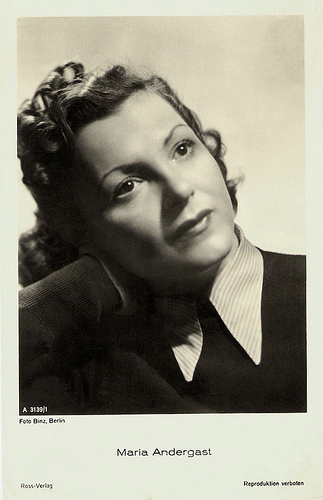
German postcard by Ross-Verlag, no. A 3139/1, 1941-1944. Photo: Titia Binz, Berlin.
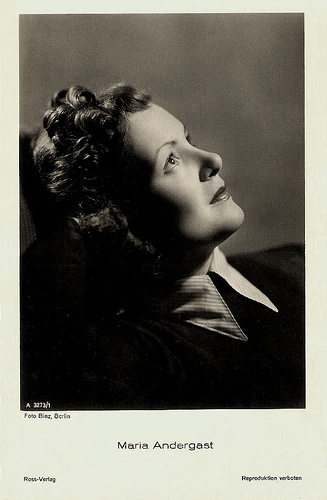
German postcard by Ross-Verlag, no. A 3273/1, 1941-1944. Photo: Titia Binz, Berlin.
The bride faithfully waiting in her mountain village
Maria Andergast was born Maria Pitzer in 1912 in Brunnthal an der Alz, in Austria. At the age of 2, she lost her parents. She grew up with relatives in Vienna and took their names.
Maria took dance lessons with Grete Wiesenthal, but a serious traffic accident destroyed her dreams of a dance career. Instead, she took acting lessons with Josef Danegger at the Akademie für Musik und darstellende Kunst Wien.
In 1928, she had her first stage work in the city of Aussig (now Ústí nad Labem in the Czech Republic). At the Stadttheater Aussig she made her debut in the play Vater sein dagegen sehr. Later she worked at the German Landestheater in Prague and at the Theater in der Josefstadt in Vienna.
In 1932, Maria Andergast was discovered for the screen by actor-director Luis Trenker , but she had to cancel the role that he offered her in his film Der Rebell/The Rebel (Kurt Bernhardt, Edwin H. Knopf, Luis Trenker, 1932) because of scheduling problems. The collaboration with Trenker came in his masterpiece Der verlorene Sohn/The Prodigal Son (Luis Trenker, 1934), in which she embodied the bride, who faithfully waits in her mountain village for her wandering boyfriend.
In her second film, Abenteuer eines jungen Herrn in Polen/The Adventures of a Young Master in Poland (Gustav Fröhlich, 1934), she played a Russian countess, who must renounce her love for an Austrian officer ( Gustav Fröhlich ) under the political conditions of the First World War.
After that she was immediately given the opportunity to play further main roles in successful films like Der Vogelhändler/The Bird Seller (E.W. Emo, 1935) and Skandal um die Fledermaus/Scandal at the Fledermaus (Herbert Selpin, 1936) with Viktor de Kowa.
German Wikipedia : “She played sweet, simple, basic girl types, who, despite a certain inclination to melancholy, are prepared to fight for their happiness. That this happiness was usually quite conventional, and that the possibilities for action of these female figures were often limited to the option of an heroic renunciation, did not damage Maria Andergast's popularity.”
In 1936 Andergast married film director Heinz Helbig and she played leading roles in three of his films. She went with him to Berlin, where she continued to be engaged in the theatre. From 1939 onwards, she lived and worked mainly in Vienna, but as a stage actress she also travelled to Rome, Warsaw, Switzerland and Sweden.
During the Second World War, Andergast appeared in two Nazi propaganda films, Spähtrupp Hallgarten (Herbert B. Fredersdorf, 1941) and Sechs Tage Heimaturlaub (Jürgen von Alten, 1941). For the first time she also received an offer for an artistically interesting film role: in E.W. Emo's Der liebe Augustin/The Dear Augustin (1940) she could show a bit more of her acting talents as a friend of the title figure.
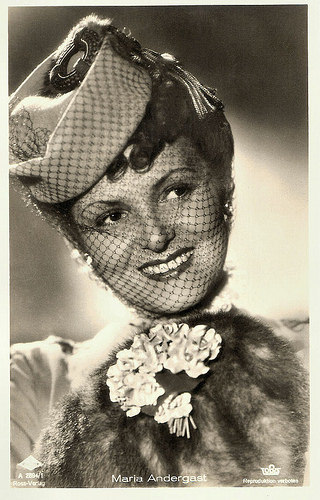
German postcard by Ross-Verlag, no. A 2894/1, 1939-1940. Photo: Wien-Film / Tobis.
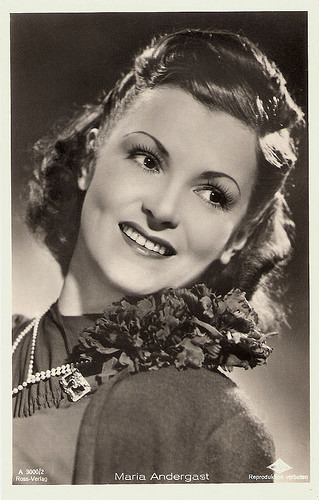
German postcard by Ross-Verlag, no. A 3000/2, 1941-1944. Photo: Wien-Film.
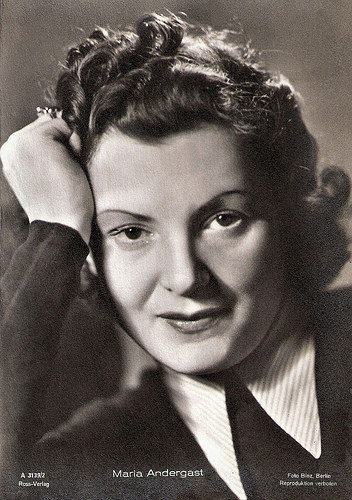
German postcard by Ross-Verlag, no. A 3139/2, 1941-1944. Photo: Titia Binz, Berlin.
A second career as Schlager singer
After the end of the Second World War, Maria Andergast performed at the Theater in der Josefstadt and at the Residenztheater in Munich. Another interesting film role followed in 1946, when Andergast played the slanderous wife of a war hero ( Rudolf Prack ) in the first Austrian post-war film Der weite Weg/The Long Way (Eduard Hoesch, 1946).
In her next film, Der Hofrat Geiger/Counsellor Geiger (Hans Wolff, 1947), she performed the song Mariandl, composed by Hans Lang. This formed the starting point for a second career as a singer for Andergast. She also sang the Schlager Du bist die Rose vom Wörthersee (You are the rose of Lake Wörther) by Hans Lang in 1950.
Popular films were Der alte Sünder/The old Sinner (Franz Antel, 1951) starring Paul Hörbiger , Hallo Dienstmann/Hello Dienstmann (Franz Antel, 1952) with Hans Moser , Der Verschwender/The Spendthrift (Leopold Hainisch, 1953) and Verlobung am Wolfgangsee/Engagement at Lake Wolfgang (Helmut Weiss, 1956) with Wolf Albach-Retty .
Since then, she only appeared in supporting parts. After suffering serious injuries in 1966, she entered into a long professional break. Since the 1960s, Maria Andergast was occasionally seen in television productions. In 1972, she relocated from Munich to Vienna. In the following year, she was awarded the silver honorary needle of the State of Vienna.
In 1974, she made her final film, the Heimat-melodrama Der Gestohlene Himmel/The Stolen Heaven (Theo Maria Werner, 1974).
In 1995 she died of cancer. Parts of her estate are now in the Potsdam Filmmuseum. Maria Andergast was married three times: with the director Heinz Helbig, the actor Siegfried Breuer and the actor and director Richard Häußler (1958-1964, until his death). With the director Franz Antel, who staged five of her films from 1950 onwards, she was engaged for a long time. In 2002 the Maria-Andergast-Weg was named after her in Donaustadt, Vienna.
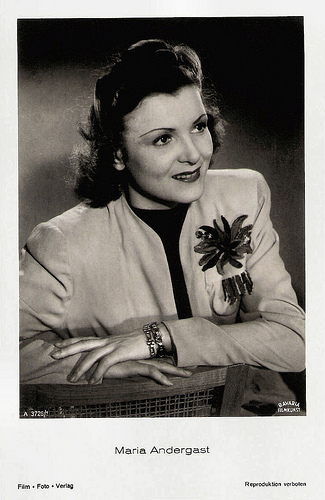
German postcard by Film-Foto-Verlag, no. A 3726/1, 1941-1944. Photo: Bavaria Filmkunst.
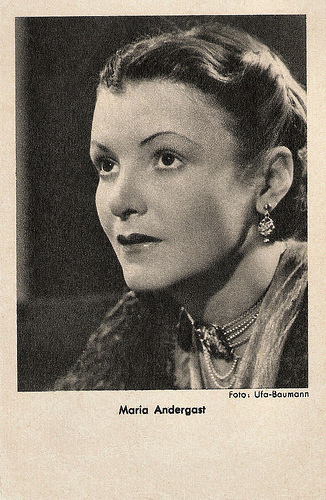
German postcard by Das Programm von Heute / Ross Verlag, Berlin. Photo: Baumann / Ufa.
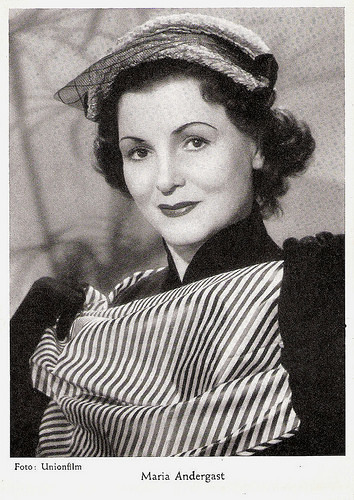
German collectors card. Photo: Unionfilm.
Sources: Stephanie d’Heil (Steffi-Line – German), Thomas Staedeli (Cyranos), Wikipedia (English and German), and .

German postcard by Ross-Verlag, no. A 3139/1, 1941-1944. Photo: Titia Binz, Berlin.

German postcard by Ross-Verlag, no. A 3273/1, 1941-1944. Photo: Titia Binz, Berlin.
The bride faithfully waiting in her mountain village
Maria Andergast was born Maria Pitzer in 1912 in Brunnthal an der Alz, in Austria. At the age of 2, she lost her parents. She grew up with relatives in Vienna and took their names.
Maria took dance lessons with Grete Wiesenthal, but a serious traffic accident destroyed her dreams of a dance career. Instead, she took acting lessons with Josef Danegger at the Akademie für Musik und darstellende Kunst Wien.
In 1928, she had her first stage work in the city of Aussig (now Ústí nad Labem in the Czech Republic). At the Stadttheater Aussig she made her debut in the play Vater sein dagegen sehr. Later she worked at the German Landestheater in Prague and at the Theater in der Josefstadt in Vienna.
In 1932, Maria Andergast was discovered for the screen by actor-director Luis Trenker , but she had to cancel the role that he offered her in his film Der Rebell/The Rebel (Kurt Bernhardt, Edwin H. Knopf, Luis Trenker, 1932) because of scheduling problems. The collaboration with Trenker came in his masterpiece Der verlorene Sohn/The Prodigal Son (Luis Trenker, 1934), in which she embodied the bride, who faithfully waits in her mountain village for her wandering boyfriend.
In her second film, Abenteuer eines jungen Herrn in Polen/The Adventures of a Young Master in Poland (Gustav Fröhlich, 1934), she played a Russian countess, who must renounce her love for an Austrian officer ( Gustav Fröhlich ) under the political conditions of the First World War.
After that she was immediately given the opportunity to play further main roles in successful films like Der Vogelhändler/The Bird Seller (E.W. Emo, 1935) and Skandal um die Fledermaus/Scandal at the Fledermaus (Herbert Selpin, 1936) with Viktor de Kowa.
German Wikipedia : “She played sweet, simple, basic girl types, who, despite a certain inclination to melancholy, are prepared to fight for their happiness. That this happiness was usually quite conventional, and that the possibilities for action of these female figures were often limited to the option of an heroic renunciation, did not damage Maria Andergast's popularity.”
In 1936 Andergast married film director Heinz Helbig and she played leading roles in three of his films. She went with him to Berlin, where she continued to be engaged in the theatre. From 1939 onwards, she lived and worked mainly in Vienna, but as a stage actress she also travelled to Rome, Warsaw, Switzerland and Sweden.
During the Second World War, Andergast appeared in two Nazi propaganda films, Spähtrupp Hallgarten (Herbert B. Fredersdorf, 1941) and Sechs Tage Heimaturlaub (Jürgen von Alten, 1941). For the first time she also received an offer for an artistically interesting film role: in E.W. Emo's Der liebe Augustin/The Dear Augustin (1940) she could show a bit more of her acting talents as a friend of the title figure.

German postcard by Ross-Verlag, no. A 2894/1, 1939-1940. Photo: Wien-Film / Tobis.

German postcard by Ross-Verlag, no. A 3000/2, 1941-1944. Photo: Wien-Film.

German postcard by Ross-Verlag, no. A 3139/2, 1941-1944. Photo: Titia Binz, Berlin.
A second career as Schlager singer
After the end of the Second World War, Maria Andergast performed at the Theater in der Josefstadt and at the Residenztheater in Munich. Another interesting film role followed in 1946, when Andergast played the slanderous wife of a war hero ( Rudolf Prack ) in the first Austrian post-war film Der weite Weg/The Long Way (Eduard Hoesch, 1946).
In her next film, Der Hofrat Geiger/Counsellor Geiger (Hans Wolff, 1947), she performed the song Mariandl, composed by Hans Lang. This formed the starting point for a second career as a singer for Andergast. She also sang the Schlager Du bist die Rose vom Wörthersee (You are the rose of Lake Wörther) by Hans Lang in 1950.
Popular films were Der alte Sünder/The old Sinner (Franz Antel, 1951) starring Paul Hörbiger , Hallo Dienstmann/Hello Dienstmann (Franz Antel, 1952) with Hans Moser , Der Verschwender/The Spendthrift (Leopold Hainisch, 1953) and Verlobung am Wolfgangsee/Engagement at Lake Wolfgang (Helmut Weiss, 1956) with Wolf Albach-Retty .
Since then, she only appeared in supporting parts. After suffering serious injuries in 1966, she entered into a long professional break. Since the 1960s, Maria Andergast was occasionally seen in television productions. In 1972, she relocated from Munich to Vienna. In the following year, she was awarded the silver honorary needle of the State of Vienna.
In 1974, she made her final film, the Heimat-melodrama Der Gestohlene Himmel/The Stolen Heaven (Theo Maria Werner, 1974).
In 1995 she died of cancer. Parts of her estate are now in the Potsdam Filmmuseum. Maria Andergast was married three times: with the director Heinz Helbig, the actor Siegfried Breuer and the actor and director Richard Häußler (1958-1964, until his death). With the director Franz Antel, who staged five of her films from 1950 onwards, she was engaged for a long time. In 2002 the Maria-Andergast-Weg was named after her in Donaustadt, Vienna.

German postcard by Film-Foto-Verlag, no. A 3726/1, 1941-1944. Photo: Bavaria Filmkunst.

German postcard by Das Programm von Heute / Ross Verlag, Berlin. Photo: Baumann / Ufa.

German collectors card. Photo: Unionfilm.
Sources: Stephanie d’Heil (Steffi-Line – German), Thomas Staedeli (Cyranos), Wikipedia (English and German), and .
Published on July 06, 2017 22:00
July 5, 2017
Etchika Choureau
The film career of French actress Etchika Choureau (1929) started very promising with three films and an award in 1953. During the 1950s the beauty with the green eyes and long blond hair graced films in France, Germany, Italy and Hollywood. After a long affair with the Crown prince of Morocco, she tried to make a come-back but failed and retired.
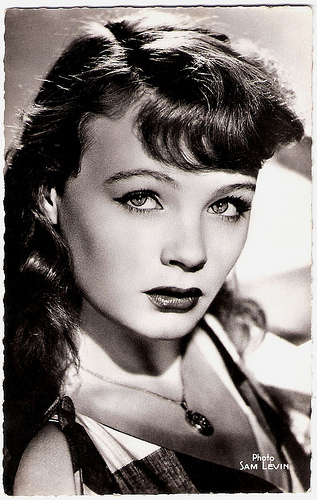
French postcard by Editions du Globe (E.D.U.G.), Paris, no. 322. Photo: Sam Lévin.
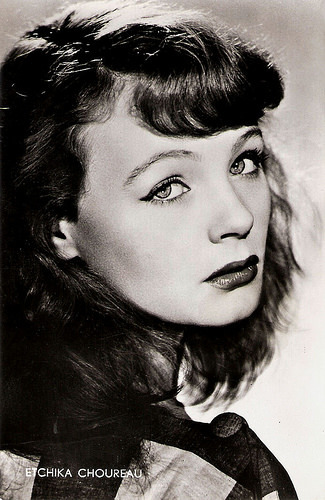
French postcard by Kores, 'Carboplane'. Photo: Unifrance film.
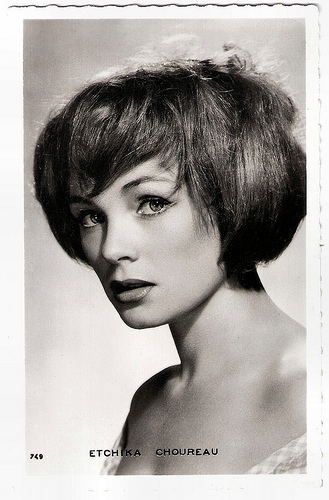
French postcard by Editions P.I., Paris, no. 749. Photo: Sam Lévin.
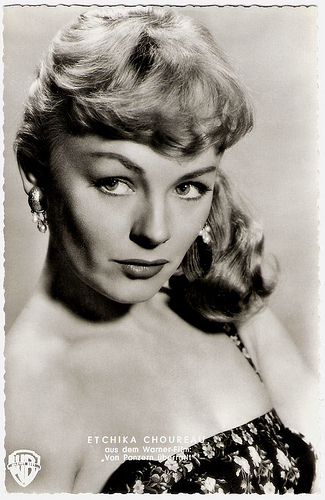
German postcard by Film und Bild, Berlin-Charlottenburg, no. A 1541. Photo: Warner Bros. Publicity still for Darby's Rangers (William A. Wellman, 1958).
Antonioni
Etchika Choureau was born Jeannine Paulette Verret in Paris in 1929 (some sources says 1923, others 1933).
In 1948 the beautiful 19-year-old girl met Max Choureau, four years her senior whose parents were beekeepers in the Gâtinais. They fell in love and were married.
After various jobs she enrolled in the Paris Conservatory of Arts to study drama. At her graduation she won the first prize in a contest with film diva Edwige Feuillère heading the jury.
Actor Alain Cuny discovered her and pushed her to accept a beautiful role in the Italian film I vinti/The Vanquished (1953), an early work of legendary director Michelangelo Antonioni. This anthology film contains three stories of well-off youths in the post-war years who commit murders, one taking place in Paris, another in Rome, and another in London.
In the French episode Sans Amour (Without Love), Choureay plays a young temptress in a gang of aimless youth from working-class families. They cold-bloodedly plan and carry out the murder of a boastful bourgeois classmate (Jean-Pierre Mocky), just out of envy. Antonioni had huge problems when he tried to find funding for such ambitious, resolutely downbeat material. The result was banned in France for a long time.
In 1953 Choureau also divorced, but kept the name of her ex-husband as a pseudonym. That same year she starred in two more remarkable films. She played a mortally ill village girl in L'envers du paradis/The Other Side of Pardise (Edmond T. Gréville, 1953) starring Erich von Stroheim .
The third film was Les enfants de l'amour/Children of Love (Léonide Moguy, 1953), a drama about unwed mothers in which she played a double role. It earned her that year le prix Suzanne-Bianchetti (the Suzanne Bianchetti award) for the Most Promising Actress.
After this jump start, she made nine more films in France, Italy and Germany during the following years. Although she co-starred in these films with stars like Jean Marais , Michel Simon and Isa Miranda , none of these productions was memorable.
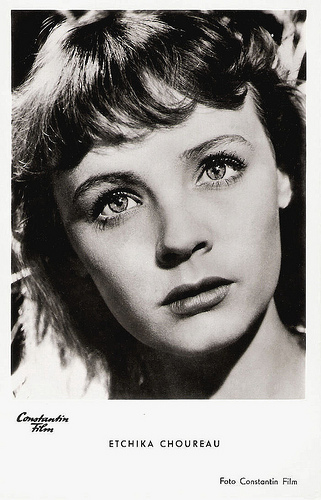
German postcard by Kunst und Bild, Berlin, no. A 1075. Photo: Constantin Film. Publicity still for Les enfants de l'amour/Children of Love (Léonide Moguy, 1953).
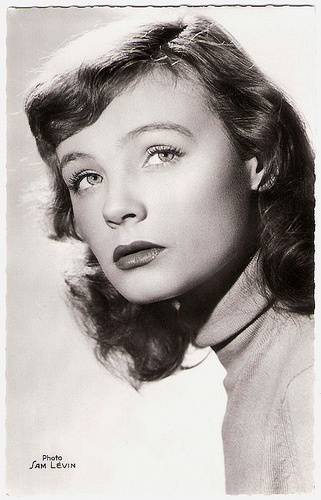
French postcard by Editions du Globe, Paris, no. 439. Photo: Sam Lévin.
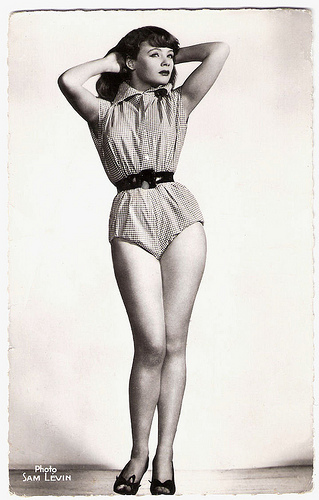
French postcard by Editions du Globe (E.D.U.G.), Paris, no. 358. Photo: Sam Lévin.
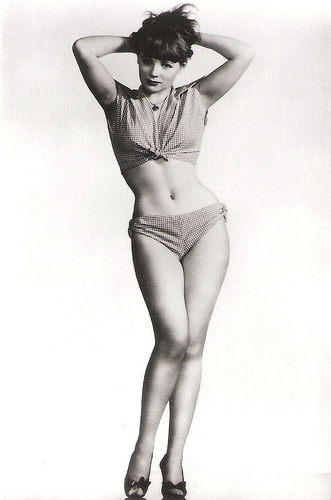
Yugoslavian postcard by Studio Sombor, no. 212.
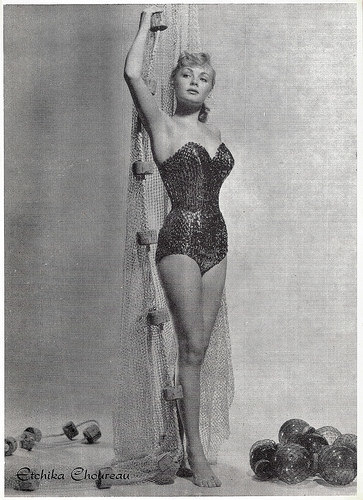 .
.
Big vintage card.
Crown Prince
In 1957 Etchika Choureau tried to conquer Hollywood. She played the female leads in two American war films made by Warner Bros.
In Darby's Rangers (William A. Wellman, 1958) she was the love interest of James Garner, and in Lafayette Escadrille (William A. Wellman, 1958) of Tab Hunter . According to the fan magazines Hunter was deeply in love with her, but his studio wouldn’t allow him to fly to Paris to visit her...
She had a real love affair with Moulay Hassan II, the Crown Prince of Morocco. She retired from the screen. In 1961 their relationship suddenly ended when Hassan was proclaimed King of Morocco following the death of His Majesty Mohammed V.
After an absence of four years, Choureau tried to revive her cinema career with three new roles. First she played the lead in the drama La prostitution/Prostitution (Maurice Boutel, 1963).
The following year she had a small part in the romantic adventure film Angélique, marquise des anges/Angélique (Bernard Borderie, 1964), the first part of the romantic Angélique cycle, set in Mid-17th century France. This huge box office hit meant the breakthrough for lead actress Michèle Mercier , but did nothing for the career of Choureau.
She played in only one more film, Paris au mois d'août/Paris in August (Pierre Granier-Deferre, 1966) as the wife of Charles Aznavour . Then she retired permanently.
Three years later, she married auctioneer Philippe Rheims. Etchika Choureau had appeared in only seventeen films.
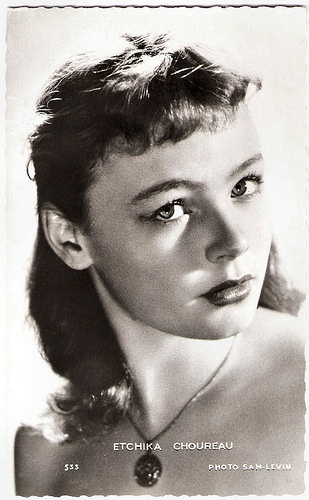
French postcard by Editions P.I., Paris, no 533. Photo: Sam Lévin.
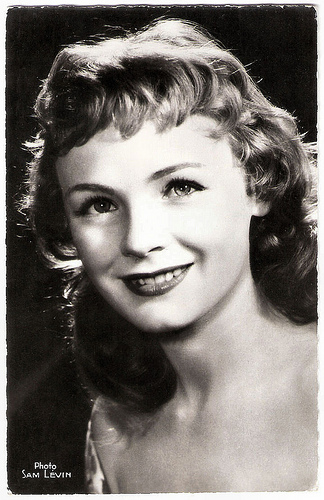
French postcard by Editions du Globe (E.D.U.G.), Paris, no. 323. Photo: Sam Lévin.
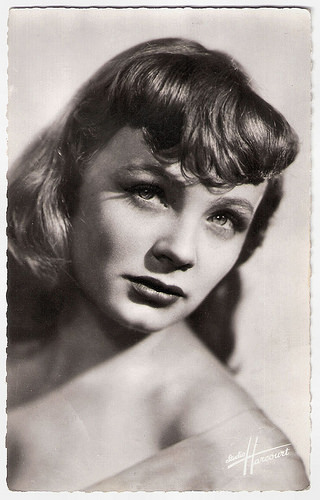
French postcard by Editions du Globe, Paris, no. 343. Photo: Studio Harcourt.
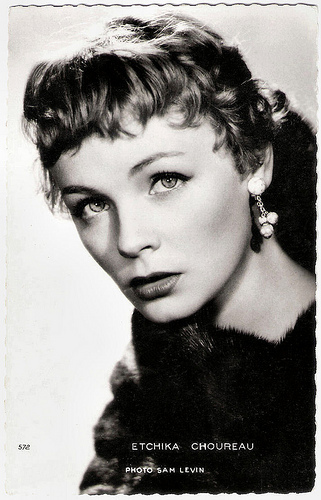
French postcard by Editions P.I., Paris, no. 572. Photo: Sam Lévin.
Sources: Yves Foucart (Les gens du Cinema), Michael Hastings (AllMovie), Glamour Girls of the Silver Screen, Wikipedia (French) and .

French postcard by Editions du Globe (E.D.U.G.), Paris, no. 322. Photo: Sam Lévin.

French postcard by Kores, 'Carboplane'. Photo: Unifrance film.

French postcard by Editions P.I., Paris, no. 749. Photo: Sam Lévin.

German postcard by Film und Bild, Berlin-Charlottenburg, no. A 1541. Photo: Warner Bros. Publicity still for Darby's Rangers (William A. Wellman, 1958).
Antonioni
Etchika Choureau was born Jeannine Paulette Verret in Paris in 1929 (some sources says 1923, others 1933).
In 1948 the beautiful 19-year-old girl met Max Choureau, four years her senior whose parents were beekeepers in the Gâtinais. They fell in love and were married.
After various jobs she enrolled in the Paris Conservatory of Arts to study drama. At her graduation she won the first prize in a contest with film diva Edwige Feuillère heading the jury.
Actor Alain Cuny discovered her and pushed her to accept a beautiful role in the Italian film I vinti/The Vanquished (1953), an early work of legendary director Michelangelo Antonioni. This anthology film contains three stories of well-off youths in the post-war years who commit murders, one taking place in Paris, another in Rome, and another in London.
In the French episode Sans Amour (Without Love), Choureay plays a young temptress in a gang of aimless youth from working-class families. They cold-bloodedly plan and carry out the murder of a boastful bourgeois classmate (Jean-Pierre Mocky), just out of envy. Antonioni had huge problems when he tried to find funding for such ambitious, resolutely downbeat material. The result was banned in France for a long time.
In 1953 Choureau also divorced, but kept the name of her ex-husband as a pseudonym. That same year she starred in two more remarkable films. She played a mortally ill village girl in L'envers du paradis/The Other Side of Pardise (Edmond T. Gréville, 1953) starring Erich von Stroheim .
The third film was Les enfants de l'amour/Children of Love (Léonide Moguy, 1953), a drama about unwed mothers in which she played a double role. It earned her that year le prix Suzanne-Bianchetti (the Suzanne Bianchetti award) for the Most Promising Actress.
After this jump start, she made nine more films in France, Italy and Germany during the following years. Although she co-starred in these films with stars like Jean Marais , Michel Simon and Isa Miranda , none of these productions was memorable.

German postcard by Kunst und Bild, Berlin, no. A 1075. Photo: Constantin Film. Publicity still for Les enfants de l'amour/Children of Love (Léonide Moguy, 1953).

French postcard by Editions du Globe, Paris, no. 439. Photo: Sam Lévin.

French postcard by Editions du Globe (E.D.U.G.), Paris, no. 358. Photo: Sam Lévin.

Yugoslavian postcard by Studio Sombor, no. 212.
 .
.Big vintage card.
Crown Prince
In 1957 Etchika Choureau tried to conquer Hollywood. She played the female leads in two American war films made by Warner Bros.
In Darby's Rangers (William A. Wellman, 1958) she was the love interest of James Garner, and in Lafayette Escadrille (William A. Wellman, 1958) of Tab Hunter . According to the fan magazines Hunter was deeply in love with her, but his studio wouldn’t allow him to fly to Paris to visit her...
She had a real love affair with Moulay Hassan II, the Crown Prince of Morocco. She retired from the screen. In 1961 their relationship suddenly ended when Hassan was proclaimed King of Morocco following the death of His Majesty Mohammed V.
After an absence of four years, Choureau tried to revive her cinema career with three new roles. First she played the lead in the drama La prostitution/Prostitution (Maurice Boutel, 1963).
The following year she had a small part in the romantic adventure film Angélique, marquise des anges/Angélique (Bernard Borderie, 1964), the first part of the romantic Angélique cycle, set in Mid-17th century France. This huge box office hit meant the breakthrough for lead actress Michèle Mercier , but did nothing for the career of Choureau.
She played in only one more film, Paris au mois d'août/Paris in August (Pierre Granier-Deferre, 1966) as the wife of Charles Aznavour . Then she retired permanently.
Three years later, she married auctioneer Philippe Rheims. Etchika Choureau had appeared in only seventeen films.

French postcard by Editions P.I., Paris, no 533. Photo: Sam Lévin.

French postcard by Editions du Globe (E.D.U.G.), Paris, no. 323. Photo: Sam Lévin.

French postcard by Editions du Globe, Paris, no. 343. Photo: Studio Harcourt.

French postcard by Editions P.I., Paris, no. 572. Photo: Sam Lévin.
Sources: Yves Foucart (Les gens du Cinema), Michael Hastings (AllMovie), Glamour Girls of the Silver Screen, Wikipedia (French) and .
Published on July 05, 2017 22:00
July 4, 2017
Anita Björk
Swedish actress Anita Björk was a leading lady of the Swedish theatre with more than 80 roles. Björk repeatedly worked for Ingmar Bergman, both onstage and onscreen. The slender, dark-haired beauty played in over 50 films and TV-series. Her international breakthrough came with the title role in Alf Sjöberg's Strindberg adaptation Fröken Julie/Miss Julie (1951) which won the grand prize at Cannes. Hollywood winked at ‘the new Garbo’, but when the studios learned that she was an unwed mother, they shied away.
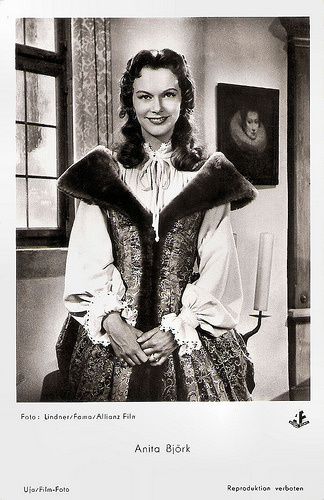
German postcard by Ufa, no. FK 2112. Photo: Lindner / Fama / Alianz Film. Publicity still for Der Cornet - Die Weise von Liebe und Tod/The Cornet (Gustav Ucicky, 1955).
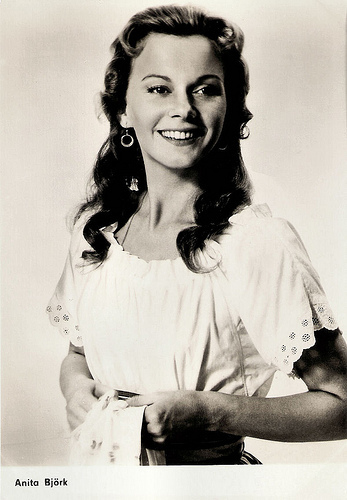
East-German postcard by VEB Progress Filmvertrieb, no. 2.337, 1965. Retail price: 0,20 MDN.
A cool aura not unlike that of Greta Garbo
Anita Barbro Kristina Björk was born in Tallberg, a town in central Sweden.
She was bitten by the acting bug in her teens and went to Stockholm. There she attended the acting school of the Royal Dramatic Theater, known as Dramaten, in 1942-45 with Mai Zetterling, the actress who later became Sweden's most recognized female film director.
Björk quickly got major roles. In 1942 she also made her film debut with a small role in the monumental classic Himlaspelet/The Heavenly Play (Alf Sjöberg, 1942), about a poor farmer (Rune Lindström) who makes a deal with devil. Other small parts followed in films like the thriller Det kom en gäst/A Guest Is Coming (Arne Mattsson, 1947).
Her breakthrough came in Jean Genet's play The Maids (1948), followed by such roles as Agnes in Henrik Ibsen's Brand, Juliet in William Shakespeare's Romeo & Juliet, Eliza in George Bernard Shaw's Pygmalion and Tintomara in Carl Jonas Love Almqvist's Drottningens juvelsmycke.
In his obituary for Variety , Jon Asp writes: “Bjork was considered the leading lady of Swedish theater, with a cool aura not unlike that of Greta Garbo . Bjork's deep, self-restrained voice was impossible to confuse with anyone else's.”
She played in several films, including Kvartetten som sprängdes/The Quartet That Split Up (Gustaf Molander, 1950). Bjork's international breakthrough came with the title role in the film Fröken Julie/Miss Julie (Alf Sjöberg, 1951), based on the famous play by August Strindberg.
Narrias Thuresson writes at IMDb : “Anita Björk is able to use simple means to give depth and character to a role. She has a way of expressing any emotion just by raising an eyebrow or twitching her lips. This was something she used to a large extent in her best movie, Alf Sjöberg's Fröken Julie (1951) where she played the young lady at a country manor, planning to elope with Jean the butler.” The film won the grand prize at the Cannes Film Festival.
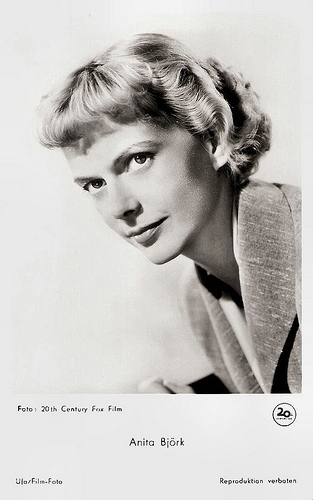
German postcard by Ufa, no. FK 1408. Photo: 20th Century Fox. Publicity still for Night People (Nunnally Johnson, 1954).
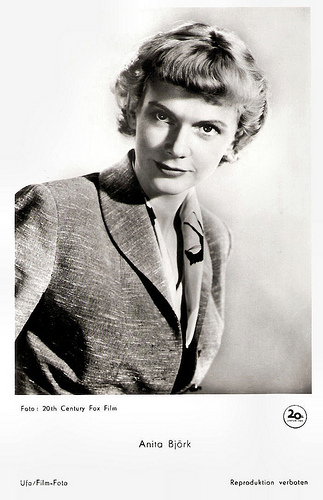
German postcard by Ufa, no. FK 1410. Photo: 20th Century Fox. Publicity still for Night People (Nunnally Johnson, 1954).
An invitation from Hollywood
After the success of Fröken Julie, Anita Björk was acclaimed by American newspapers as ‘the new Garbo’ and received an invitation from Hollywood. She was offered the female lead in Alfred Hitchcock's I Confess (1953), but suddenly the offer was withdrawn and the role was ultimately played by Anne Baxter.
Earlier, Björk had met and fallen in love with Stig Dagerman, one of Sweden’s most important writers. In 1951 she had given birth to their daughter Lo. The three of them had gone to Hollywood for Anita to negotiate the role in I Confess. But when word came out that Björk wasn't married to Dagerman, Hollywood immediately lost interest.
Dagerman’s divorce from his ex-wife wasn't final until 1953 and Hollywood did not accept a contract player who lived with someone married to somebody else and who was an unmarried mother. In 1953, Dagerman and Björk could finally marry.
For Twentieth Century Fox, Anita Björk then starred opposite Gregory Peck in the Cold War thriller Night People (Nunnally Johnson, 1954), shot in England and Germany. She also appeared with Karlheinz Böhm in the German production Die Hexe/The Witch (Gustav Ucicky, 1954). But when the films failed at the box office, so did her international career.
Björk soon moved back to Stockholm. At the end of 1954, her husband Stig Dagerman committed suicide. Björk decided to stick to the Royal Dramatic Theatre where she would appear in more than 80 roles through the years.
She also appeared in Swedish films as the melodrama Sången om den eldröda blomman/Song of the Scarlet Flower (Gustaf Molander, 1956) and the thrillers Damen i svart/The Lady in Black (Arne Mattsson, 1958) and Mannekäng i rött/Mannequin in Red (Arne Mattsson, 1958).
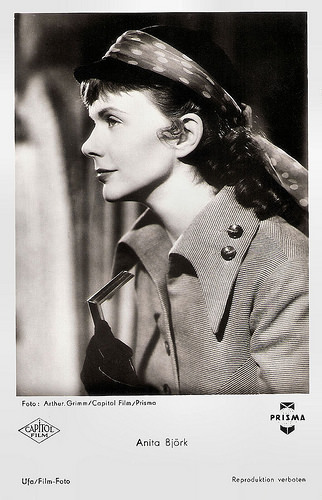
German postcard by Ufa, no. FK 1051. Photo: Arthur Grimm / Capitol Film / Prisma. Publicity still for Die Hexe/The Witch (Gustav Ucicky, 1954).
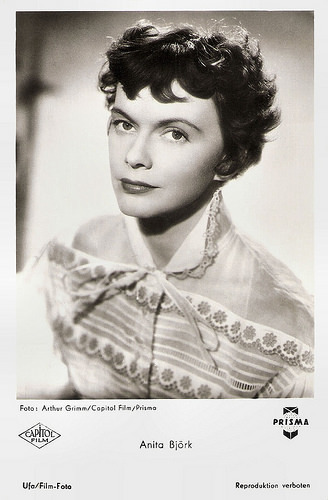
German postcard by Ufa, no. FK 1052. Photo: Arthur Grimm / Capitol Film / Prisma. Publicity still for Die Hexe/The Witch (Gustav Ucicky, 1954).
12 productions by Ingmar Bergman
For MGM, Anita Björk appeared in the war drama Square of Violence (Leonardo Bercovici, 1961) starring Broderick Crawford . Under the direction of Mai Zetterling , she appeared in the romantic drama Älskande par/Loving Couples (1964) and under the direction of Bo Widerberg in his Ådalen 31/Adalen Riots (1969).
Björk performed in 12 productions by famous director Ingmar Bergman. First, she played in his film Kvinnors väntan/Waiting Women (Ingmar Bergman, 1952). And at the end of her career in 1998, she performed in his TV film Bildmakarna/The Image Makers (1998).
Bildmakarna was based on the play by Bergman’s son-in-law Per Olov Endquist. It is a fictionalized dramatization about the making of Bergman's favorite film, Körkarlen/The Phantom Carriage (Victor Sjöström, 1921). Bergman saw this classic of the silent Scandinavian cinema reportedly over 100 times, and the film prompted him to become a film-maker.
In Bildmakarna Björk offered a memorable interpretation of Swedish writer and Nobel laureate Selma Lagerlöf on whose novel Körkarlen/The Phantom Carriage was based. The play, also directed by Bergman, went on tour in Europe and also played the Brooklyn Academy of Music in New York.
Bjork also played Queen Victoria in Cannes Palme d'Or winner Den goda viljan/The Best Intentions (Bille August, 1992), a film based on Bergman's autobiographical novel about his parents. The actress finally performed in A.R. Gurney's Kärleksbrev/Love Letters (2009) under direction of Gunnel Lindblom at Teater Brunnsgatan Fyra in Stockholm.
In 2012, Anita Bjork died in her hmetown Stockholm. She was 89. Before Stig Dagerman, Björk had been married to actor Olof Bergström (1945-1951). Their son is actor Jonas Bergström. After Dagerman's death, she had a relationship with novelist Graham Greene.
Trailer Fröken Julie/Miss Julie (Alf Sjöberg, 1951). Source: Video Detective (YouTube).
Sources: Jon Asp (Variety), Bruce Weber (The New York Times), (IMDb), Wikipedia and .

German postcard by Ufa, no. FK 2112. Photo: Lindner / Fama / Alianz Film. Publicity still for Der Cornet - Die Weise von Liebe und Tod/The Cornet (Gustav Ucicky, 1955).

East-German postcard by VEB Progress Filmvertrieb, no. 2.337, 1965. Retail price: 0,20 MDN.
A cool aura not unlike that of Greta Garbo
Anita Barbro Kristina Björk was born in Tallberg, a town in central Sweden.
She was bitten by the acting bug in her teens and went to Stockholm. There she attended the acting school of the Royal Dramatic Theater, known as Dramaten, in 1942-45 with Mai Zetterling, the actress who later became Sweden's most recognized female film director.
Björk quickly got major roles. In 1942 she also made her film debut with a small role in the monumental classic Himlaspelet/The Heavenly Play (Alf Sjöberg, 1942), about a poor farmer (Rune Lindström) who makes a deal with devil. Other small parts followed in films like the thriller Det kom en gäst/A Guest Is Coming (Arne Mattsson, 1947).
Her breakthrough came in Jean Genet's play The Maids (1948), followed by such roles as Agnes in Henrik Ibsen's Brand, Juliet in William Shakespeare's Romeo & Juliet, Eliza in George Bernard Shaw's Pygmalion and Tintomara in Carl Jonas Love Almqvist's Drottningens juvelsmycke.
In his obituary for Variety , Jon Asp writes: “Bjork was considered the leading lady of Swedish theater, with a cool aura not unlike that of Greta Garbo . Bjork's deep, self-restrained voice was impossible to confuse with anyone else's.”
She played in several films, including Kvartetten som sprängdes/The Quartet That Split Up (Gustaf Molander, 1950). Bjork's international breakthrough came with the title role in the film Fröken Julie/Miss Julie (Alf Sjöberg, 1951), based on the famous play by August Strindberg.
Narrias Thuresson writes at IMDb : “Anita Björk is able to use simple means to give depth and character to a role. She has a way of expressing any emotion just by raising an eyebrow or twitching her lips. This was something she used to a large extent in her best movie, Alf Sjöberg's Fröken Julie (1951) where she played the young lady at a country manor, planning to elope with Jean the butler.” The film won the grand prize at the Cannes Film Festival.

German postcard by Ufa, no. FK 1408. Photo: 20th Century Fox. Publicity still for Night People (Nunnally Johnson, 1954).

German postcard by Ufa, no. FK 1410. Photo: 20th Century Fox. Publicity still for Night People (Nunnally Johnson, 1954).
An invitation from Hollywood
After the success of Fröken Julie, Anita Björk was acclaimed by American newspapers as ‘the new Garbo’ and received an invitation from Hollywood. She was offered the female lead in Alfred Hitchcock's I Confess (1953), but suddenly the offer was withdrawn and the role was ultimately played by Anne Baxter.
Earlier, Björk had met and fallen in love with Stig Dagerman, one of Sweden’s most important writers. In 1951 she had given birth to their daughter Lo. The three of them had gone to Hollywood for Anita to negotiate the role in I Confess. But when word came out that Björk wasn't married to Dagerman, Hollywood immediately lost interest.
Dagerman’s divorce from his ex-wife wasn't final until 1953 and Hollywood did not accept a contract player who lived with someone married to somebody else and who was an unmarried mother. In 1953, Dagerman and Björk could finally marry.
For Twentieth Century Fox, Anita Björk then starred opposite Gregory Peck in the Cold War thriller Night People (Nunnally Johnson, 1954), shot in England and Germany. She also appeared with Karlheinz Böhm in the German production Die Hexe/The Witch (Gustav Ucicky, 1954). But when the films failed at the box office, so did her international career.
Björk soon moved back to Stockholm. At the end of 1954, her husband Stig Dagerman committed suicide. Björk decided to stick to the Royal Dramatic Theatre where she would appear in more than 80 roles through the years.
She also appeared in Swedish films as the melodrama Sången om den eldröda blomman/Song of the Scarlet Flower (Gustaf Molander, 1956) and the thrillers Damen i svart/The Lady in Black (Arne Mattsson, 1958) and Mannekäng i rött/Mannequin in Red (Arne Mattsson, 1958).

German postcard by Ufa, no. FK 1051. Photo: Arthur Grimm / Capitol Film / Prisma. Publicity still for Die Hexe/The Witch (Gustav Ucicky, 1954).

German postcard by Ufa, no. FK 1052. Photo: Arthur Grimm / Capitol Film / Prisma. Publicity still for Die Hexe/The Witch (Gustav Ucicky, 1954).
12 productions by Ingmar Bergman
For MGM, Anita Björk appeared in the war drama Square of Violence (Leonardo Bercovici, 1961) starring Broderick Crawford . Under the direction of Mai Zetterling , she appeared in the romantic drama Älskande par/Loving Couples (1964) and under the direction of Bo Widerberg in his Ådalen 31/Adalen Riots (1969).
Björk performed in 12 productions by famous director Ingmar Bergman. First, she played in his film Kvinnors väntan/Waiting Women (Ingmar Bergman, 1952). And at the end of her career in 1998, she performed in his TV film Bildmakarna/The Image Makers (1998).
Bildmakarna was based on the play by Bergman’s son-in-law Per Olov Endquist. It is a fictionalized dramatization about the making of Bergman's favorite film, Körkarlen/The Phantom Carriage (Victor Sjöström, 1921). Bergman saw this classic of the silent Scandinavian cinema reportedly over 100 times, and the film prompted him to become a film-maker.
In Bildmakarna Björk offered a memorable interpretation of Swedish writer and Nobel laureate Selma Lagerlöf on whose novel Körkarlen/The Phantom Carriage was based. The play, also directed by Bergman, went on tour in Europe and also played the Brooklyn Academy of Music in New York.
Bjork also played Queen Victoria in Cannes Palme d'Or winner Den goda viljan/The Best Intentions (Bille August, 1992), a film based on Bergman's autobiographical novel about his parents. The actress finally performed in A.R. Gurney's Kärleksbrev/Love Letters (2009) under direction of Gunnel Lindblom at Teater Brunnsgatan Fyra in Stockholm.
In 2012, Anita Bjork died in her hmetown Stockholm. She was 89. Before Stig Dagerman, Björk had been married to actor Olof Bergström (1945-1951). Their son is actor Jonas Bergström. After Dagerman's death, she had a relationship with novelist Graham Greene.
Trailer Fröken Julie/Miss Julie (Alf Sjöberg, 1951). Source: Video Detective (YouTube).
Sources: Jon Asp (Variety), Bruce Weber (The New York Times), (IMDb), Wikipedia and .
Published on July 04, 2017 22:00
July 3, 2017
Sophie Hardy
Sexy French starlet Sophie Hardy (1944) was a popular pin-up in the mid-1960s. She was often pictured by glamour photographer Bruno Bernard, better known as Bernard of Hollywood. First the blonde actress appeared as eye-candy in French films, and later she was a successful leading lady in popular German, English and Spanish productions.
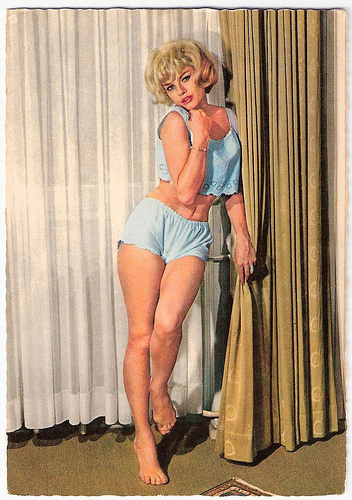
German postcard by Kruger, no. 902/290. Photo: Bernard of Hollywood. This is one of our most popular filmcards on Flickr: over 43,000 views and counting.
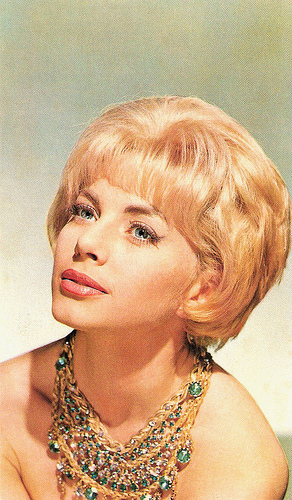
French postcard by E.D.U.G., no. 317, offered by Corvisart. Photo: Sam Lévin.
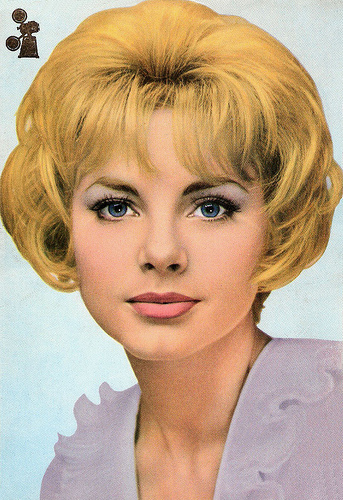
Spanish postcard by Postalcolor, Barcelona, no. 127. Photo: Sam Lévin.
Sexy Crime Film
Sophie Hardy was born in Paris, France in 1944. She got acting lessons from Françoise Rosay and Yves Furet. At the Sorbonne she studied American literature.
In 1960 she made her film debut in the Philippinean production Pitong gabi sa Paris/A Philippine in Paris (Eddie Romero, 1960).
In 1962, small parts followed in such films as the tragi-comedy Un clair de lune à Maubeuge/Moonlight in Maubeuge (Jean Chérasse, 1962) with Claude Brasseur and Michel Serrault , and the Film Noir La loi des hommes/Law of Men (Charles Gérard, 1962) starring Micheline Presle .
The next years she appeared in the French-Italian Swashbuckler Hardi! Pardaillan/The Gallant Musketeer (Bernard Borderie, 1963), starring Gérard Barray . She had her first big role in L'étrange auto-stoppeuse/The strange hitch-hiker (Jean Darcy, 1964) with Georges Marchal .
Opposite tough-guy Eddie Constantine she was the leading lady in the detective film Des frissons partout/Jeff Gordon, Secret Agent (Raoul André, 1964).
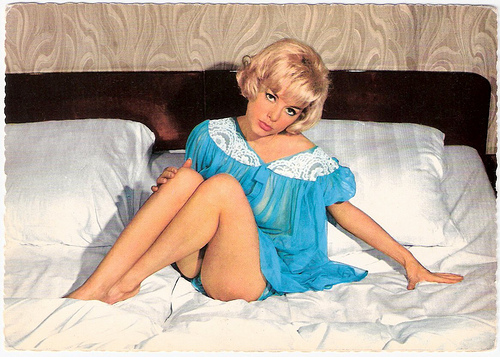
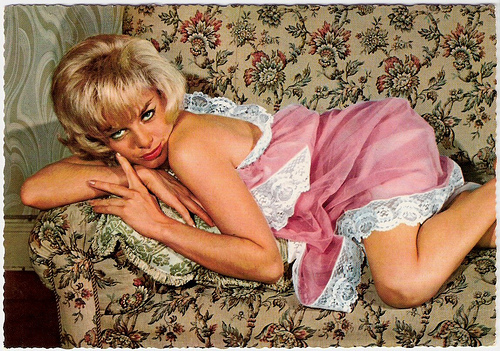
German postcards by Krüger, no. 902/311 and no. 902/292. Photos: Bernard of Hollywood .
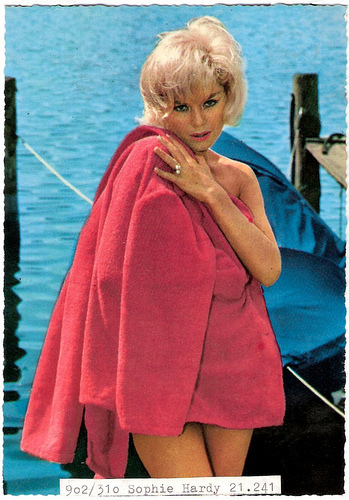
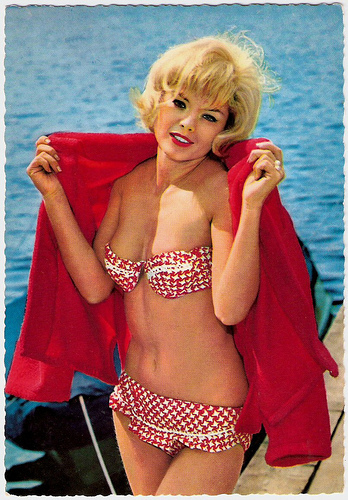
German postcards by Kruger, no. 902/310 and no. 902/289. Photos: Bernard of Hollywood.
Winnetou
Sophie Hardy went to Germany to play one of the lead roles in the softcore sex film Treibgut der Liebe/La baie du désir/The Erotic Touch of Hot Skin (Max Pécas, 1964) about sex, murder, false identities, car crashes, and striptease at the French Riviera.
Hal Erickson at AllMovie comments: "A fine cast does wonders with tawdry material. (...) In case you aren't interested in sex and sin, be advised that Erotic Touch of Hot Skin runs only 78 minutes, hardly long enough to induce boredom."
She stayed in Germany for more big parts in the popular Edgar Wallace adaptations Der Hexer/The Mysterious Magician (Alfred Vohrer, 1964) with Joachim Fuchsberger , and Das Geheimnis der weissen Nonne/The Trygon Factor (Cyril Frankel, 1966), in which she co-starred with Stewart Granger . Der Hexer was adapted from the 1925 novel by Edgar Wallace titled The Ringer (originally: The Gaunt Stranger) and Das Geheimnis der weissen Nonne is based on the Edgar Wallace novel Kate Plus Ten.
She also co-starred in the Karl May Western Winnetou III/The Desperado Trail (Harald Reinl, 1965) featuring Pierre Brice .
At the time she was a popular model for film and glamour magazines, such as Cinémonde, Ciné-Revue and V magazine in France, Er in Germany and Modern Man in the US.
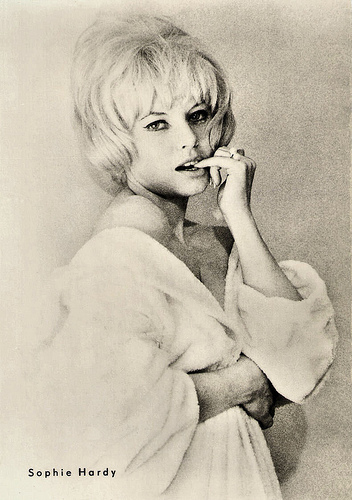
East-German postcard by Progress, no. 162/70. Photo: Steffen.
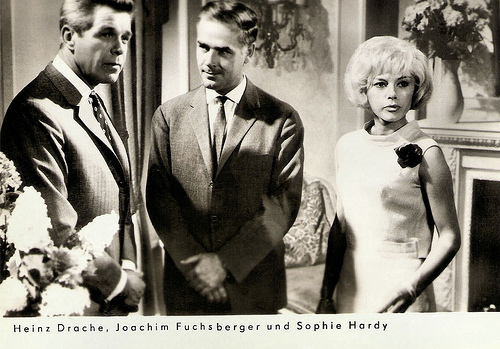
East-German postcard by Progress, no. 165/70. Photo: publicity still for Der Hexer/The Ringer (Alfred Vohrer, 1964) with Heinz Drache and Joachim Fuchsberger.
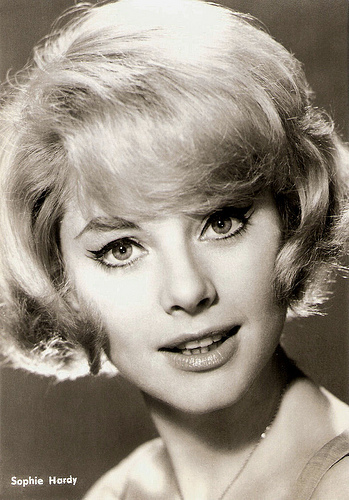
East-German postcard by Progress, no. 127/70. Photo: Unifrance Film.
Pixie Dream Girl
In Spain, Sophie Hardy appeared as a go-go dancer in the enjoyable Sci-Fi/Spy-Comedy Cartas boca arriba/Attack of the Robots (Jesus Franco, 1966) again opposite Eddie Constantine .
Rod Barnett writes as his blog Bloody Pit of Rod : "This evening (as threatened) I watched Jess Franco's ATTACK OF THE ROBOTS (1966) a.k.a. CARTES SUR TABLE and enjoyed it quite a lot. Its a fun comedy/spy adventure with some great fights, some fun dialog and a nice breezy style. But the most impressive thing visually was actress Sophia Hardy. Wowsa! She has a kind of 'pixie dream girl' thing going on with a smile that could melt steel plating. In this film she had dark hair but from the photos I can find she may have actually been a blond. Or not. I don't care!"
Hardy traveled to London to play the title figure in the Swinging Sixties comedy Three Hats for Lisa (Sidney Hayers, 1965), typically her role was that of a foreign film star in London, who asks two young fans to steal some hats for her collection. The star-struck youths agree until they learn that she wants a bobby's helmet, a businessman's bowler, and a palace guard's cap.
After this busy career period it became quiet around Hardy. The next years she was only seen in a supporting role in the British spy thriller A Taste of Excitement (Don Sharp, 1969) starring Eva Renzi. Its U.S. title was Why Would Anyone Want to Kill a Nice Girl Like You?
Hardy also appeared in the sexy psychological drama Road to Salina (Georges Lautner, 1970), a French-Italian coproduction with Robert Walker, Mimsy Farmer and Rita Hayworth in one of her last roles.
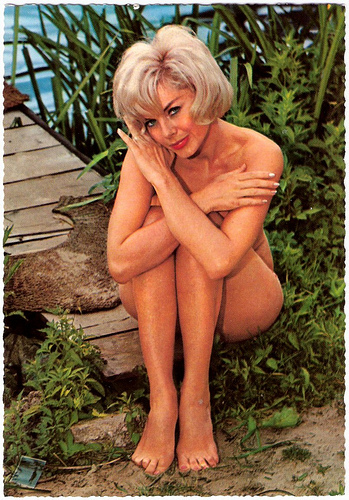
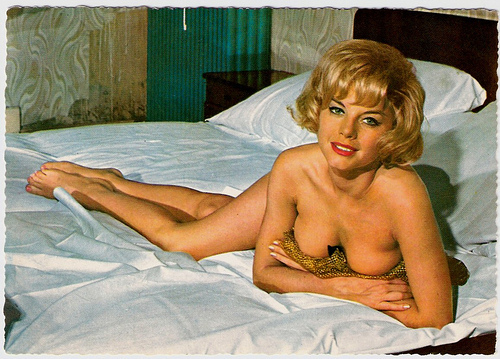
German postcards by Kruger, no. 902/291 and no. 902/293. Photos: Bernard of Hollywood .
Come Back
Sophie Hardy's film career then had a long interruption of more than 20 years, in which she worked for a year as a presenter for the television of Luxemburg.
In 1994 she returned to the screen in a small role in the TV film Jules (Christian Palligiano, 1994).
Six years later she made a come back as the grandmother of Aurélien Wiik in an episode of the Scénarios sur la drogue/Drug Scenes/Drugs! (2000). Scénarios sur la drogue is an omnibus film (2000) of 24 French short films depicting drug abuse. Varying in length from three to seven minutes, they were showed in cinemas before feature films. Sophie Hardy appeared in the episode La Puré, which was directed by Seb and Simon Lelouch, sons of famous director Claude Lelouch.
Sophie Hardy was later seen in Casablanca Driver (Maurice Barthélémy, 2004), a fictional documentary about a man who wants to become a boxer.
Her most recent TV credit is a guest role in the long-running Soap opera Plus belle la vie/PBLV (2012). And two years later she appeared in the short comedy-drama C'est le ciel qui vous envoie!/You are heaven sent (Pierre Aboujaoude, 2014).
Trailer for The Erotic Touch Of Hot Skin (1965). Source: Vulture Graffix (YouTube).
Trailer for Der Hexer/The Mysterious Magician (1964). Source: RialtoFilm (YouTube).
Trailer for Winnetou III/The Desperado Trail (1965). Source: RialtoFilm (YouTube).
Sources: Thomas Staedeli (Cyranos), Rod Barnett (Bloody Pit of Rod), Hal Erickson (AllMovie), Cinéthéa, Wikipedia(German and English) and .

German postcard by Kruger, no. 902/290. Photo: Bernard of Hollywood. This is one of our most popular filmcards on Flickr: over 43,000 views and counting.

French postcard by E.D.U.G., no. 317, offered by Corvisart. Photo: Sam Lévin.

Spanish postcard by Postalcolor, Barcelona, no. 127. Photo: Sam Lévin.
Sexy Crime Film
Sophie Hardy was born in Paris, France in 1944. She got acting lessons from Françoise Rosay and Yves Furet. At the Sorbonne she studied American literature.
In 1960 she made her film debut in the Philippinean production Pitong gabi sa Paris/A Philippine in Paris (Eddie Romero, 1960).
In 1962, small parts followed in such films as the tragi-comedy Un clair de lune à Maubeuge/Moonlight in Maubeuge (Jean Chérasse, 1962) with Claude Brasseur and Michel Serrault , and the Film Noir La loi des hommes/Law of Men (Charles Gérard, 1962) starring Micheline Presle .
The next years she appeared in the French-Italian Swashbuckler Hardi! Pardaillan/The Gallant Musketeer (Bernard Borderie, 1963), starring Gérard Barray . She had her first big role in L'étrange auto-stoppeuse/The strange hitch-hiker (Jean Darcy, 1964) with Georges Marchal .
Opposite tough-guy Eddie Constantine she was the leading lady in the detective film Des frissons partout/Jeff Gordon, Secret Agent (Raoul André, 1964).


German postcards by Krüger, no. 902/311 and no. 902/292. Photos: Bernard of Hollywood .


German postcards by Kruger, no. 902/310 and no. 902/289. Photos: Bernard of Hollywood.
Winnetou
Sophie Hardy went to Germany to play one of the lead roles in the softcore sex film Treibgut der Liebe/La baie du désir/The Erotic Touch of Hot Skin (Max Pécas, 1964) about sex, murder, false identities, car crashes, and striptease at the French Riviera.
Hal Erickson at AllMovie comments: "A fine cast does wonders with tawdry material. (...) In case you aren't interested in sex and sin, be advised that Erotic Touch of Hot Skin runs only 78 minutes, hardly long enough to induce boredom."
She stayed in Germany for more big parts in the popular Edgar Wallace adaptations Der Hexer/The Mysterious Magician (Alfred Vohrer, 1964) with Joachim Fuchsberger , and Das Geheimnis der weissen Nonne/The Trygon Factor (Cyril Frankel, 1966), in which she co-starred with Stewart Granger . Der Hexer was adapted from the 1925 novel by Edgar Wallace titled The Ringer (originally: The Gaunt Stranger) and Das Geheimnis der weissen Nonne is based on the Edgar Wallace novel Kate Plus Ten.
She also co-starred in the Karl May Western Winnetou III/The Desperado Trail (Harald Reinl, 1965) featuring Pierre Brice .
At the time she was a popular model for film and glamour magazines, such as Cinémonde, Ciné-Revue and V magazine in France, Er in Germany and Modern Man in the US.

East-German postcard by Progress, no. 162/70. Photo: Steffen.

East-German postcard by Progress, no. 165/70. Photo: publicity still for Der Hexer/The Ringer (Alfred Vohrer, 1964) with Heinz Drache and Joachim Fuchsberger.

East-German postcard by Progress, no. 127/70. Photo: Unifrance Film.
Pixie Dream Girl
In Spain, Sophie Hardy appeared as a go-go dancer in the enjoyable Sci-Fi/Spy-Comedy Cartas boca arriba/Attack of the Robots (Jesus Franco, 1966) again opposite Eddie Constantine .
Rod Barnett writes as his blog Bloody Pit of Rod : "This evening (as threatened) I watched Jess Franco's ATTACK OF THE ROBOTS (1966) a.k.a. CARTES SUR TABLE and enjoyed it quite a lot. Its a fun comedy/spy adventure with some great fights, some fun dialog and a nice breezy style. But the most impressive thing visually was actress Sophia Hardy. Wowsa! She has a kind of 'pixie dream girl' thing going on with a smile that could melt steel plating. In this film she had dark hair but from the photos I can find she may have actually been a blond. Or not. I don't care!"
Hardy traveled to London to play the title figure in the Swinging Sixties comedy Three Hats for Lisa (Sidney Hayers, 1965), typically her role was that of a foreign film star in London, who asks two young fans to steal some hats for her collection. The star-struck youths agree until they learn that she wants a bobby's helmet, a businessman's bowler, and a palace guard's cap.
After this busy career period it became quiet around Hardy. The next years she was only seen in a supporting role in the British spy thriller A Taste of Excitement (Don Sharp, 1969) starring Eva Renzi. Its U.S. title was Why Would Anyone Want to Kill a Nice Girl Like You?
Hardy also appeared in the sexy psychological drama Road to Salina (Georges Lautner, 1970), a French-Italian coproduction with Robert Walker, Mimsy Farmer and Rita Hayworth in one of her last roles.


German postcards by Kruger, no. 902/291 and no. 902/293. Photos: Bernard of Hollywood .
Come Back
Sophie Hardy's film career then had a long interruption of more than 20 years, in which she worked for a year as a presenter for the television of Luxemburg.
In 1994 she returned to the screen in a small role in the TV film Jules (Christian Palligiano, 1994).
Six years later she made a come back as the grandmother of Aurélien Wiik in an episode of the Scénarios sur la drogue/Drug Scenes/Drugs! (2000). Scénarios sur la drogue is an omnibus film (2000) of 24 French short films depicting drug abuse. Varying in length from three to seven minutes, they were showed in cinemas before feature films. Sophie Hardy appeared in the episode La Puré, which was directed by Seb and Simon Lelouch, sons of famous director Claude Lelouch.
Sophie Hardy was later seen in Casablanca Driver (Maurice Barthélémy, 2004), a fictional documentary about a man who wants to become a boxer.
Her most recent TV credit is a guest role in the long-running Soap opera Plus belle la vie/PBLV (2012). And two years later she appeared in the short comedy-drama C'est le ciel qui vous envoie!/You are heaven sent (Pierre Aboujaoude, 2014).
Trailer for The Erotic Touch Of Hot Skin (1965). Source: Vulture Graffix (YouTube).
Trailer for Der Hexer/The Mysterious Magician (1964). Source: RialtoFilm (YouTube).
Trailer for Winnetou III/The Desperado Trail (1965). Source: RialtoFilm (YouTube).
Sources: Thomas Staedeli (Cyranos), Rod Barnett (Bloody Pit of Rod), Hal Erickson (AllMovie), Cinéthéa, Wikipedia(German and English) and .
Published on July 03, 2017 22:00
July 2, 2017
Hanni Weisse
German actress Hanni Weisse (1892-1967) belonged to the great film divas of the early German silent film. She was able to maintain her stardom till the late 1920s.
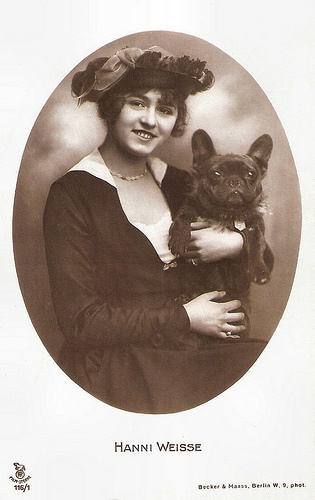
German postcard in the Film Sterne Series by Rotophot, no. 116/1, 1928-1929. Photo: Becker & Maas, Berlin.
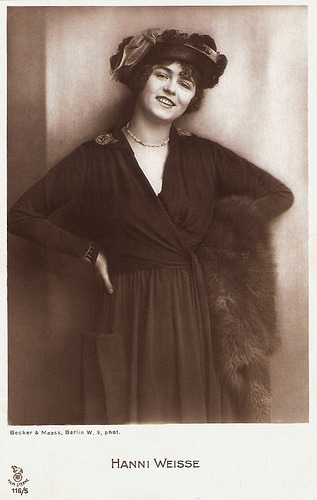
German postcard in the Film Sterne series by Rotophot, no. 116/5. Photo: Becker & Maass, Berlin.
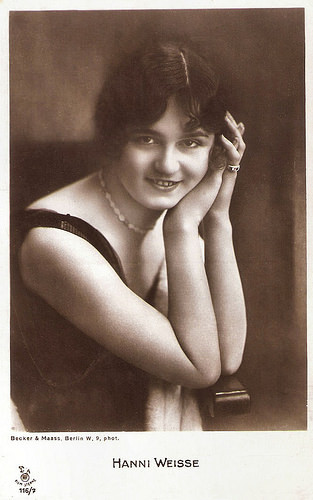
German postcard in the Film Sterne Series by Rotophot, no. 116/7, 1928-1929. Photo: Becker & Maas, Berlin.
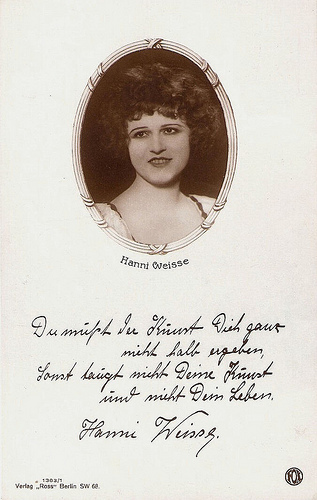
German postcard by Ross Verlag, no. 1383/1, 1927 -1928. Photo: Fox.
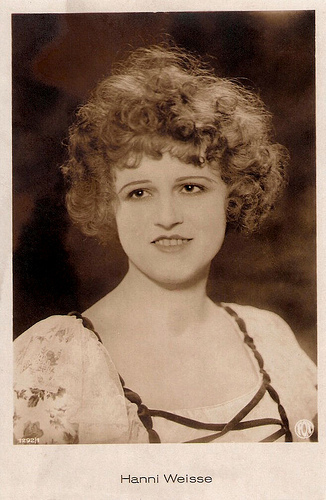
German postcard by Ross Verlag (?), no. 1292/1, 1927-1928. Photo: Fox. Probably the lower side of this card was cut off. The same photo was used for Ross card no. 1383/1.
Sherlock Holmes
Hanni Klara Therese Weisse was born in Chemnitz, Germany in 1892.
She studied to play the cello, but started her musical career in 1910 as a chorister at the Thalia-Theater in Berlin. In 1912 she was an ensemble member of the Royal Belvedere Dresden, which made a national tour through Germany.
In Berlin she had a chance meeting with film director Max Mack, who engaged her for the production company Vitascope. She made her film debut in his short Der Zigeunerin/The Gypsy (Max Mack, 1912) with Ernst Pittschau.
One of her first successes was Der Andere/The Other (Max Mack, 1913), starring Albert Bassermann , which according to critics belonged to the first art films.
In the following years she appeared in many great productions like Das Eiserne Kreuz/The Iron Cross (Richard Oswald, 1914), Anita Jo (Dimitri Buchowetzki, 1919), Die Apachen/The Apaches (Ewald André Dupont, 1919), Alkohol/Alcohol (Ewald André Dupont, Alfred Lind, 1920) and the horror film Der Graf von Cagliostro/The Count of Cagliostro (Reinhold Schünzel, 1920) starring Anita Berber and Conrad Veidt .
She was also playing in the very popular Sherlock Holmes films such as Der Hund von Baskerville/The Hound of the Baskervilles (Rudolf Meinert, 1914) and Das dunkle Schloß/The Dark Castle (Willy Zeyn, 1915).
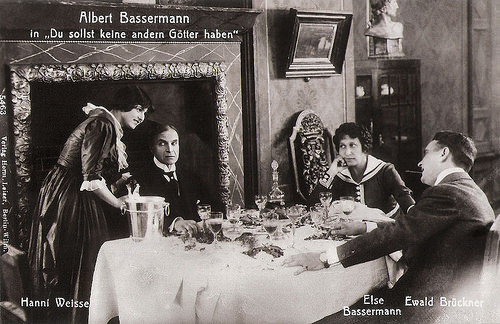
German postcard by Verlag Hermann Leiser, Berlin-Wilm., no. 5463. Photo: publicity still for Du sollst keine andern Götter haben/Thou shalt have no other gods (Adolf Gärtner, 1917) with Albert Bassermann, Hanni Weisse, Else Bassemann and Ewald Brückner.
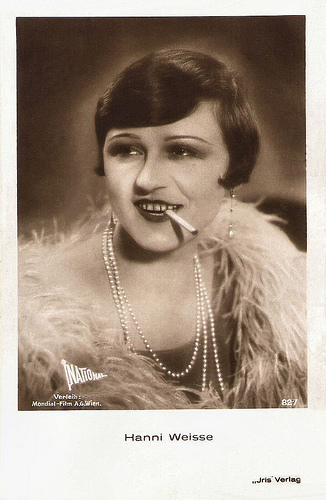
Austrian postcard by Iris Verlag, no. 827. Photo: National / Mondial-Film A.G., Wien.
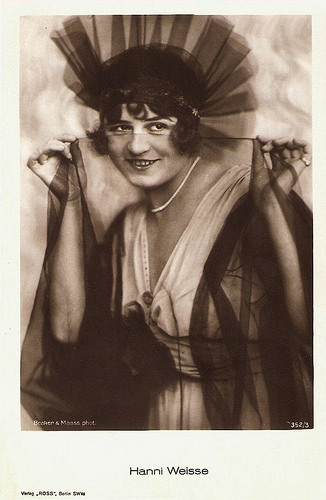
German postcard by Ross Verlag, no. 352/3, 1919-1924. Photo: Becker & Maass.
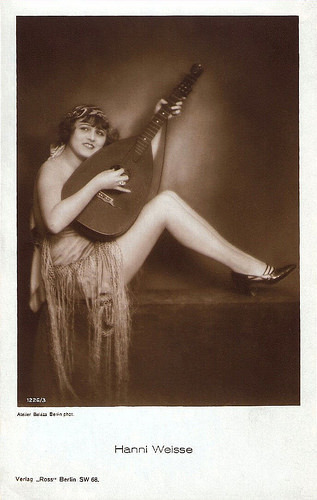
German postcard by Ross Verlag, no. 1226/3, 1927-1928. Photo: Atelier Balázs, Berlin.
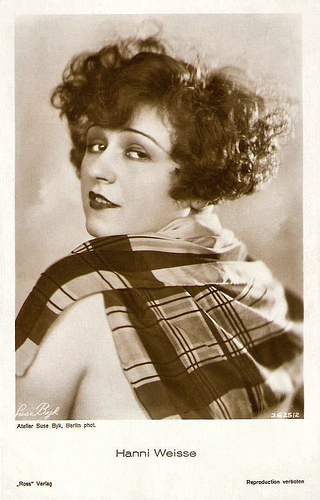
German Postcard by Ross Verlag, no. 3625/2, 1928-1929. Photo: Atelier Suse Byk, Berlin.
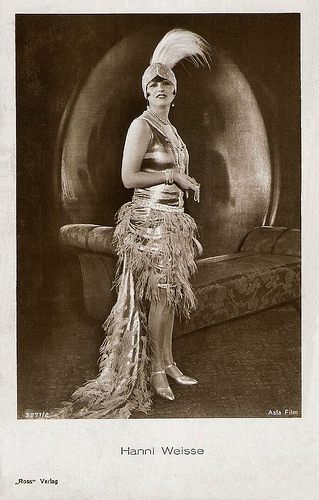
German postcard by Ross Verlag, no. 3271/2, 1928-1929. Photo: Aafa Film.
Busy Actress
In the 1920s Hanni Weisse was a very busy actress and played in films like Die Insel der Verschollenen/The Island of the Lost (Urban Gad, 1921), Nanon (Hanns Schwarz, 1924), Die Drei Portiermädel/The Three Porter Girls (Carl Boese, 1925), Le train sans yeux/Train Without Eyes (Alberto Cavalcanti, 1927), Männer vor der Ehe/Men Before Marriage (Constantin J. David, 1927) and Kaczmarek (Carl Wilhelm, 1928) with Ernst Verebes .
Her engagements in the 1930s became rarer, new faces were in demand. She had roles in short comedies and played small parts in Die Heilige und ihr Narr/The Saint and Her Fool (Hans Deppe, Paul May, 1935), Krach im Hinterhaus/Trouble Backstairs (Veit Harlan, 1936) and Sergeant Berry (Herbert Selpin, 1939) starring Hans Albers .
In 1942 she made her last film Vom Schicksal verweht/Blown Away By Fate (1942, Nunzio Malasomma) featuring Sybille Schmitz . After 127 films Hanni Weisse retired from show business.
In her later years she and her second husband managed hotel-restaurants and bars, first in Aussig and Dresden, and from 1948 on in Frankfurt a.M. Her hotel-restaurant Zum Heidelberger became a popular meeting place there for artists.
Hanni Weisse died in 1967 in Bad Liebenzell, Germany. Her first marriage was to scriptwriter Bobby E. Lüthge, who wrote the scripts for her films Mater dolorosa (1924), Der Kavalier vom Wedding (1927) and Kaczmarek (1928) .
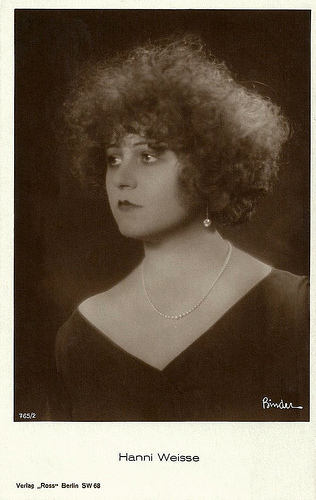
German postcard by Ross Verlag, no. 765/2, 1925-1926. Photo: Alex Binder.
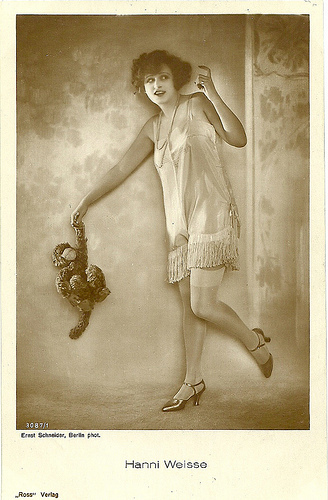
German postcard by Ross Verlag, no. 3087/1, 1928-1929. Photo: Ernst Schneider, Berlin.
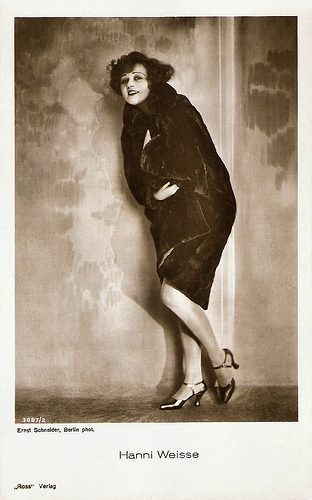
German postcard by Ross Verlag, no. 3087/2, 1928-1929. Photo: Ernst Schneider, Berlin.
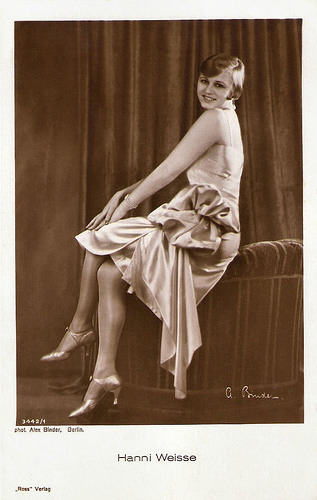
German postcard by Ross Verlag, no. 3442/1, 1928-1929. Photo: Alex Binder, Berlin.
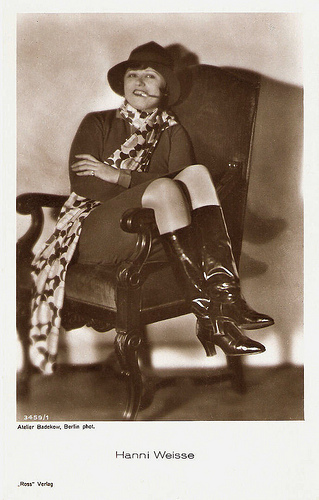
German postcard by Ross Verlag, no. 3459/1, 1928-1929. Photo: Atelier Badekow Berlin.
Sources: Thomas Staedeli (Cyranos), Filmportal.de, Wikipedia (German) and .

German postcard in the Film Sterne Series by Rotophot, no. 116/1, 1928-1929. Photo: Becker & Maas, Berlin.

German postcard in the Film Sterne series by Rotophot, no. 116/5. Photo: Becker & Maass, Berlin.

German postcard in the Film Sterne Series by Rotophot, no. 116/7, 1928-1929. Photo: Becker & Maas, Berlin.

German postcard by Ross Verlag, no. 1383/1, 1927 -1928. Photo: Fox.

German postcard by Ross Verlag (?), no. 1292/1, 1927-1928. Photo: Fox. Probably the lower side of this card was cut off. The same photo was used for Ross card no. 1383/1.
Sherlock Holmes
Hanni Klara Therese Weisse was born in Chemnitz, Germany in 1892.
She studied to play the cello, but started her musical career in 1910 as a chorister at the Thalia-Theater in Berlin. In 1912 she was an ensemble member of the Royal Belvedere Dresden, which made a national tour through Germany.
In Berlin she had a chance meeting with film director Max Mack, who engaged her for the production company Vitascope. She made her film debut in his short Der Zigeunerin/The Gypsy (Max Mack, 1912) with Ernst Pittschau.
One of her first successes was Der Andere/The Other (Max Mack, 1913), starring Albert Bassermann , which according to critics belonged to the first art films.
In the following years she appeared in many great productions like Das Eiserne Kreuz/The Iron Cross (Richard Oswald, 1914), Anita Jo (Dimitri Buchowetzki, 1919), Die Apachen/The Apaches (Ewald André Dupont, 1919), Alkohol/Alcohol (Ewald André Dupont, Alfred Lind, 1920) and the horror film Der Graf von Cagliostro/The Count of Cagliostro (Reinhold Schünzel, 1920) starring Anita Berber and Conrad Veidt .
She was also playing in the very popular Sherlock Holmes films such as Der Hund von Baskerville/The Hound of the Baskervilles (Rudolf Meinert, 1914) and Das dunkle Schloß/The Dark Castle (Willy Zeyn, 1915).

German postcard by Verlag Hermann Leiser, Berlin-Wilm., no. 5463. Photo: publicity still for Du sollst keine andern Götter haben/Thou shalt have no other gods (Adolf Gärtner, 1917) with Albert Bassermann, Hanni Weisse, Else Bassemann and Ewald Brückner.

Austrian postcard by Iris Verlag, no. 827. Photo: National / Mondial-Film A.G., Wien.

German postcard by Ross Verlag, no. 352/3, 1919-1924. Photo: Becker & Maass.

German postcard by Ross Verlag, no. 1226/3, 1927-1928. Photo: Atelier Balázs, Berlin.

German Postcard by Ross Verlag, no. 3625/2, 1928-1929. Photo: Atelier Suse Byk, Berlin.

German postcard by Ross Verlag, no. 3271/2, 1928-1929. Photo: Aafa Film.
Busy Actress
In the 1920s Hanni Weisse was a very busy actress and played in films like Die Insel der Verschollenen/The Island of the Lost (Urban Gad, 1921), Nanon (Hanns Schwarz, 1924), Die Drei Portiermädel/The Three Porter Girls (Carl Boese, 1925), Le train sans yeux/Train Without Eyes (Alberto Cavalcanti, 1927), Männer vor der Ehe/Men Before Marriage (Constantin J. David, 1927) and Kaczmarek (Carl Wilhelm, 1928) with Ernst Verebes .
Her engagements in the 1930s became rarer, new faces were in demand. She had roles in short comedies and played small parts in Die Heilige und ihr Narr/The Saint and Her Fool (Hans Deppe, Paul May, 1935), Krach im Hinterhaus/Trouble Backstairs (Veit Harlan, 1936) and Sergeant Berry (Herbert Selpin, 1939) starring Hans Albers .
In 1942 she made her last film Vom Schicksal verweht/Blown Away By Fate (1942, Nunzio Malasomma) featuring Sybille Schmitz . After 127 films Hanni Weisse retired from show business.
In her later years she and her second husband managed hotel-restaurants and bars, first in Aussig and Dresden, and from 1948 on in Frankfurt a.M. Her hotel-restaurant Zum Heidelberger became a popular meeting place there for artists.
Hanni Weisse died in 1967 in Bad Liebenzell, Germany. Her first marriage was to scriptwriter Bobby E. Lüthge, who wrote the scripts for her films Mater dolorosa (1924), Der Kavalier vom Wedding (1927) and Kaczmarek (1928) .

German postcard by Ross Verlag, no. 765/2, 1925-1926. Photo: Alex Binder.

German postcard by Ross Verlag, no. 3087/1, 1928-1929. Photo: Ernst Schneider, Berlin.

German postcard by Ross Verlag, no. 3087/2, 1928-1929. Photo: Ernst Schneider, Berlin.

German postcard by Ross Verlag, no. 3442/1, 1928-1929. Photo: Alex Binder, Berlin.

German postcard by Ross Verlag, no. 3459/1, 1928-1929. Photo: Atelier Badekow Berlin.
Sources: Thomas Staedeli (Cyranos), Filmportal.de, Wikipedia (German) and .
Published on July 02, 2017 22:00
July 1, 2017
Pierre Batcheff
Today is the final day of Il Cinema Ritrovato. We finish our festival series with a post on French film actor Pierre Batcheff (1901-1932), who stars in Les amours de minuit/The Lovers of Midnight (Augusto Genina, 1931). Also this film can be seen in the section Augusto Genina: an Italian in Europe. Two years earlier, Batcheff had become famous for his part in the surrealist classic Un chien andalou/An Andalusian dog (Luis Bunuel, Salvador Dali, 1929). In 1932, the only 30-yeas-old actor committed suicide with an overdose of Veronal.
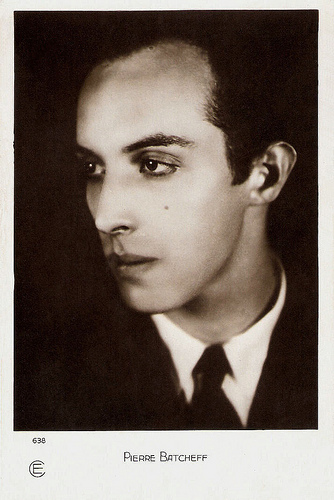
French postcard by Cinémagazine-Edition, no. 638.
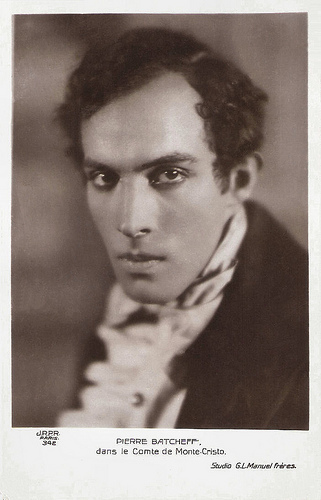
French postcard by J.R.P.R., Paris, no. 348. Photo: Studio G.L. Manuel Frères. Publicity still for Le Comte de Monte-Christo/Monte Cristo (Henri Fescourt, 1929).
Elegant Posture
Pierre Batcheff, originally Benjamin Batcheff (according to some sources Piotr Bacev), was of Russian descent. He was born in 1901 (according to some sources 1907) in Harbin, Russian Empire (now Pin-Kiang, Northeast China).
He debuted on stage in Geneva with Ludmilla and Georges Pitoëff.
In 1924 he started his cinema career in films like the comedy Claudine et le poussin/Claudine and the Chick (Marcel Manchez, 1924), in which he had the male lead opposite Dolly Davis . His good-looking appearance and his elegant posture made him a beloved jeune premier in the French cinema of the 1920s.
Before playing the memorable part of general Hoche in Abel Gance ’s epic film Napoléon (1927), he played in films as Le double amour/Double Love (Jean Epstein, 1925) with Jean Angelo , Feu Mattia Pascal/The Late Mathias Pascal (Marcel L'Herbier, 1926) starring Ivan Mozzhukhin , and Le joueur d’échecs/The Chess Player (Raymond Bernard, 1927) featuring Pierre Blanchar .
The gifted Pitoëff pupil struck because of his professional attitude. It made Pierre Batcheff one of the stars of French silent cinema.
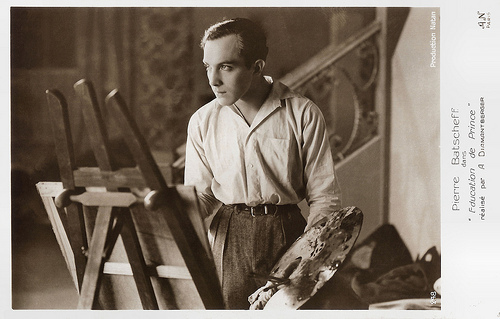
French postcard by A.N. Paris, no. 248. Photo: Production Natan. Publicity still of Pierre Batcheff in Education de prince (Henri Diamant-Berger, 1927).
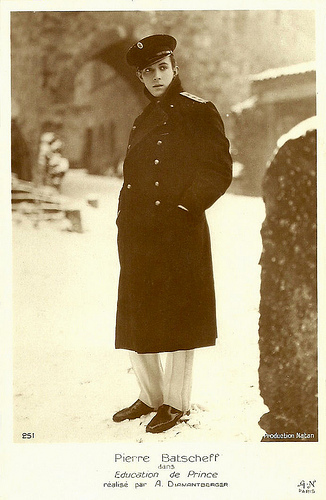
French postcard by A.N. Paris, no. 251. Photo: Production Natan. Publicity still of Pierre Batcheff in Education de prince (Henri Diamant-Berger, 1927). Collection: Didier Hanson.
Buñuel and Dali
During the shooting of La sirène des tropiques/Siren of the Tropics (Mario Nalpas, Henri Etievant, 1927) with Josephine Baker , Pierre Batcheff met the young assistant director Luis Buñuel. Buñuel offered him the leading role in his short experimental film Un chien andalou (Luis Bunuel, Salvador Dali, 1929).
His remarkable part in this absurdist classic became Batcheff’s claim of fame, although the film was never a commercial success. It was even often forbidden or censored.
Batcheff made some 25 films in 8 years, including both avant-garde films like En rade/Sea Fever (Alberto Cavalcanti, 1928) and mainstream films like Monte Cristo/Monte Christo (Henri Fescourt, 1929) starring Jean Angelo .
Despite this impressive filmography, posterity linked Batcheff exclusively to Bunuel’s film. Nobody now remembers his part in Napoléon or that in the charming, clever comedy Les deux timides/Two Timid Souls (René Clair, 1928). In the latter, Batcheff played the shy Frémissin, who is hopelessly in love with the beautiful Cécile (Véra Flory). In spite of the critic's praise for its beauty, this late silent film was a failure.
The competition of the new sound cinema was too fierce. Batcheff did some early French sound films, like Les amours de minuit/The Lovers of Midnight (Augusto Genina, Marc Allégret, 1931).
Probably his last part, he played in both the French and the English version of the adventure drama Baroud/Love in Morocco (1932-1933), director Rex Ingram’s final film.
Only 30, Pierre Batcheff died in Paris, on 13 April 1932, because of an overdose of Veronal. Though he didn’t leave a motif for his act, suspicions are that the arrival of sound cinema contributed to it. Caroline Hanotte at CinéArtistes gives another explanation: a few days earlier the Japanese army had invaded his birthtown in Russia.
Pierre Batcheff lies buried at the cemetery of Montparnasse. He was married to film editor Danièle Piazza, who later became a director and producer. Batcheff’s co-actress in Un chien andalou, Simone Mareuil, killed herself too. In 1954 she was so depressed, that she set fire to herself in a public square.
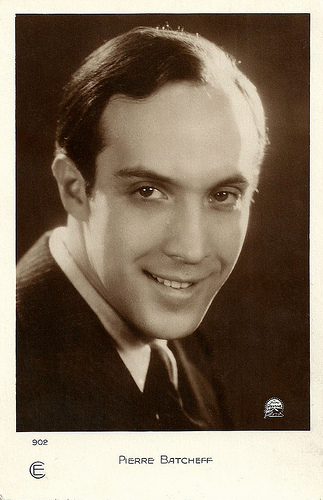
French postcard by Editions Cinémagazine, no. 902. Photo: Paramount.
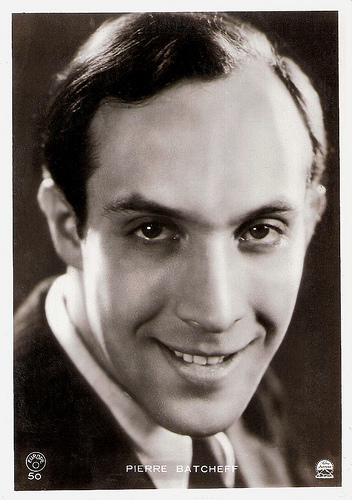
French postcard by Europe, no. 50. Photo: Paramount.
Sources: Caroline Hanotte (CinéArtistes - French), Wikipedia (English and Dutch) and .

French postcard by Cinémagazine-Edition, no. 638.

French postcard by J.R.P.R., Paris, no. 348. Photo: Studio G.L. Manuel Frères. Publicity still for Le Comte de Monte-Christo/Monte Cristo (Henri Fescourt, 1929).
Elegant Posture
Pierre Batcheff, originally Benjamin Batcheff (according to some sources Piotr Bacev), was of Russian descent. He was born in 1901 (according to some sources 1907) in Harbin, Russian Empire (now Pin-Kiang, Northeast China).
He debuted on stage in Geneva with Ludmilla and Georges Pitoëff.
In 1924 he started his cinema career in films like the comedy Claudine et le poussin/Claudine and the Chick (Marcel Manchez, 1924), in which he had the male lead opposite Dolly Davis . His good-looking appearance and his elegant posture made him a beloved jeune premier in the French cinema of the 1920s.
Before playing the memorable part of general Hoche in Abel Gance ’s epic film Napoléon (1927), he played in films as Le double amour/Double Love (Jean Epstein, 1925) with Jean Angelo , Feu Mattia Pascal/The Late Mathias Pascal (Marcel L'Herbier, 1926) starring Ivan Mozzhukhin , and Le joueur d’échecs/The Chess Player (Raymond Bernard, 1927) featuring Pierre Blanchar .
The gifted Pitoëff pupil struck because of his professional attitude. It made Pierre Batcheff one of the stars of French silent cinema.

French postcard by A.N. Paris, no. 248. Photo: Production Natan. Publicity still of Pierre Batcheff in Education de prince (Henri Diamant-Berger, 1927).

French postcard by A.N. Paris, no. 251. Photo: Production Natan. Publicity still of Pierre Batcheff in Education de prince (Henri Diamant-Berger, 1927). Collection: Didier Hanson.
Buñuel and Dali
During the shooting of La sirène des tropiques/Siren of the Tropics (Mario Nalpas, Henri Etievant, 1927) with Josephine Baker , Pierre Batcheff met the young assistant director Luis Buñuel. Buñuel offered him the leading role in his short experimental film Un chien andalou (Luis Bunuel, Salvador Dali, 1929).
His remarkable part in this absurdist classic became Batcheff’s claim of fame, although the film was never a commercial success. It was even often forbidden or censored.
Batcheff made some 25 films in 8 years, including both avant-garde films like En rade/Sea Fever (Alberto Cavalcanti, 1928) and mainstream films like Monte Cristo/Monte Christo (Henri Fescourt, 1929) starring Jean Angelo .
Despite this impressive filmography, posterity linked Batcheff exclusively to Bunuel’s film. Nobody now remembers his part in Napoléon or that in the charming, clever comedy Les deux timides/Two Timid Souls (René Clair, 1928). In the latter, Batcheff played the shy Frémissin, who is hopelessly in love with the beautiful Cécile (Véra Flory). In spite of the critic's praise for its beauty, this late silent film was a failure.
The competition of the new sound cinema was too fierce. Batcheff did some early French sound films, like Les amours de minuit/The Lovers of Midnight (Augusto Genina, Marc Allégret, 1931).
Probably his last part, he played in both the French and the English version of the adventure drama Baroud/Love in Morocco (1932-1933), director Rex Ingram’s final film.
Only 30, Pierre Batcheff died in Paris, on 13 April 1932, because of an overdose of Veronal. Though he didn’t leave a motif for his act, suspicions are that the arrival of sound cinema contributed to it. Caroline Hanotte at CinéArtistes gives another explanation: a few days earlier the Japanese army had invaded his birthtown in Russia.
Pierre Batcheff lies buried at the cemetery of Montparnasse. He was married to film editor Danièle Piazza, who later became a director and producer. Batcheff’s co-actress in Un chien andalou, Simone Mareuil, killed herself too. In 1954 she was so depressed, that she set fire to herself in a public square.

French postcard by Editions Cinémagazine, no. 902. Photo: Paramount.

French postcard by Europe, no. 50. Photo: Paramount.
Sources: Caroline Hanotte (CinéArtistes - French), Wikipedia (English and Dutch) and .
Published on July 01, 2017 22:00
June 30, 2017
Marta Toren
At Il Cinema Ritrovato, a highlight in the programme section Augusto Genina: an Italian in Europe is the highly acclaimed drama Maddalena/Magdalene (Augusto Genina, 1954).
The title role is performed by Marta Toren (1926–1957), a Swedish-American stage and film actress of the 1940s and 1950s with mesmerising eyes. During her tragically short career, she spent more time in Hollywood and Italy than in her native country.
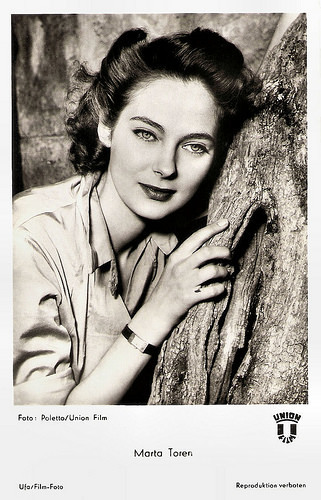
German postcard by Ufa, Berlin-Tempelhof, no FK 1079. Photo: Poletto / Union-Film. Publicity still for Maddalena (Augusto Gennina, 1954).
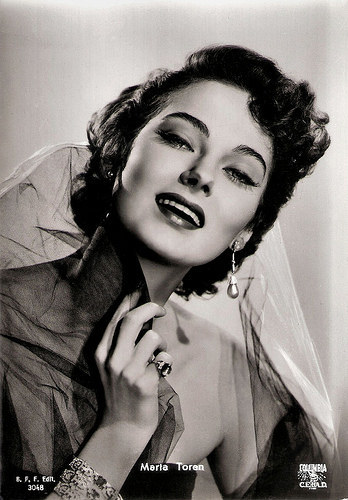
Italian postcard by B.F.F. Edit., no. 3048. Photo: Columbia CEAD.
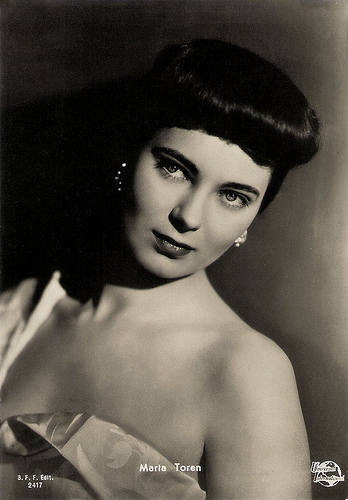
Italian postcard by B.F.F. Edit. (Casa Editr. Ballerini & Fratini), Firenze (Florence), no. 2417. Photo: Universal International.
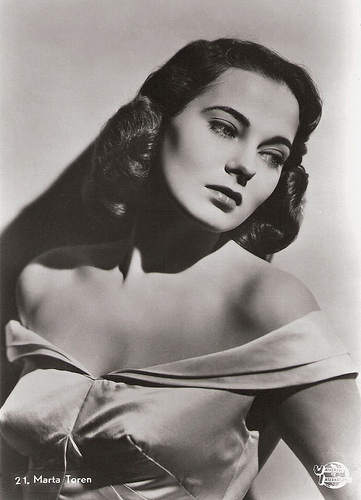
Norvegian postcard by Enerett K. Harstad, Kunstforlag, Oslo, no. 21. Photo: Universal International.
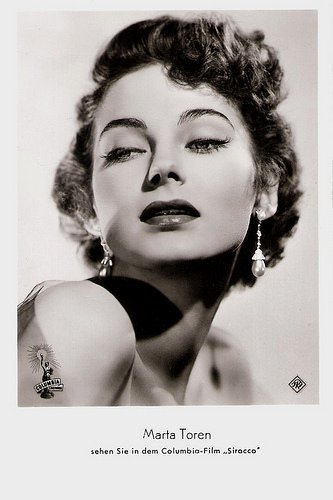
German postcard by F.J. Rüdel, Filmpostkartenverlag, Hamburg-Bergedorf, no. 431. Photo: Columbia. Publicity still for Sirocco (Curtis Bernhardt, 1951).
The Next Ingrid Bergman
Märta Torén was born in Stockholm, Sweden in 1926. Her father was Helge Toren, a major in the Life Guards regiment and, later, advertising manager for one of the daily newspapers. Her childhood was unremarkable although marred by the loss of her sister at an early age and the divorce of her parents.
The sensitive young girl dreamed to become an actress, but she was shy. She began ballet lessons under the renowned Vera Alexandrova. The lessons continued until age 14 and helped her to partly overcome her shyness.
She was an extra in the Swedish films Rospiggar (Schamyl Bauman, 1942), Ombyte av tåg/A Change of Trains (Hasse Ekman, 1943) and Eviga länkar/Eternal links (Rune Carlsten, 1946).
In 1946, her application to study acting at Dramatens elevskola (The Royal Dramatic Theater school) was accepted. She became a dedicated student under Anna Norris, a teacher who had also coached Ingrid Bergman .
After only one year, she already left her studies when she met American screen writer and talent scout Edwin Blum who was in Stockholm working on a script for RKO and looking for a leading lady. He arranged a screen test for her and not RKO but Universal-International offered her a seven-year contract.
Universal promoted her as the ‘next Ingrid Bergman ’. As Marta Toren, she made her Hollywood debut in a supporting part in Casbah (John Farrow, 1948) about the downfall of an exiled jewel thief (Tony Martin). The film was a musical remake of the French classic Pépé le Moko (Julien Duvivier, 1937) starring Jean Gabin .
Reviewer B.J. at IMDb writes: “Casbah is a film very alive with energy, style, suspense and romance. Brilliant casting; Tony Martin plays the suave thief with easy conviction and delivers the Harold Arlen songs skill, charm and gusto. Marta Toren was arguably the most beautiful woman in films, prior to the arrival of Audrey Hepburn .”
Publicity pictures focused on her beautiful eyes, which had a luminous quality with color shifting from blue to gray to greenish hues and had a fairly slight slant, giving them a faintly Oriental look. The emphasis on her eyes reached a peak with a Life magazine cover portrait in 1949 that graphically confirmed what all the hype was about.
Toren quickly appeared in a total of ten Hollywood movies. She appeared opposite James Mason in the film noir One Way Street (Hugo Fregonese, 1950), and opposite Humphrey Bogart in the Casablanca style Sirocco (Curtis Bernhardt, 1951) set in Syria, but most of her other Hollywood films are not worth remembering.
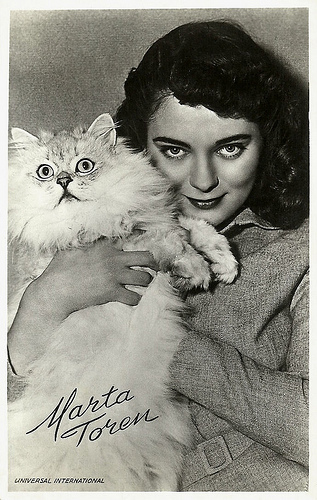
Dutch postcard by Takken, Utrecht. Photo: Universal International.
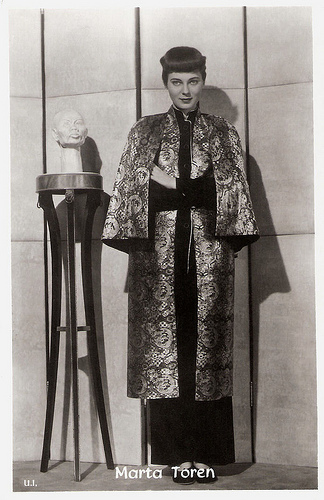
Vintage card. Photo: Universal International.
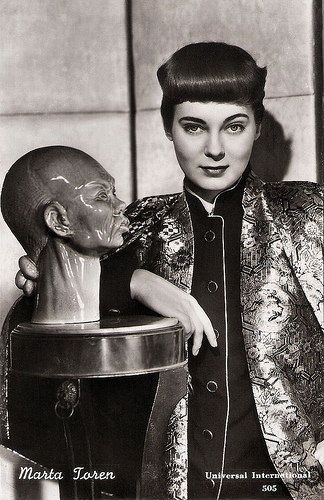
Vintage postcard, no. 505. Photo: Universal International.
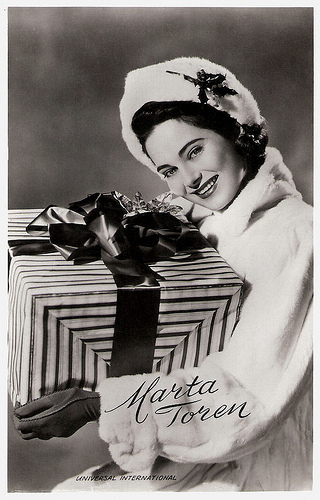
Dutch postcard, no 3374. Photo: Universal International.
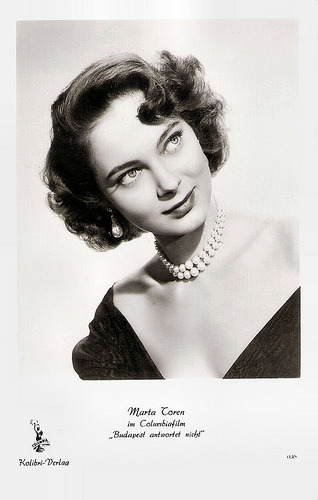
German postcard by Kolibri-Verlag, no 936. Photo: Columbia. Publicity still for Assignment: Paris (Robert Parrish, 1952).
Oedipal Relationship
In 1952 Märta Torén became a naturalized American citizen and she got married to American director and film writer Leonardo Bercovici. They would have a daughter, Christina.
She also got offers for film parts from Rome, and these roles were more demanding than what Hollywood offered her. So the family settled in Rome. There she played the wife of composer Giacomo Puccini ( Gabriele Ferzetti ) in the biopic Puccini/The Life of Puccini (Carmine Gallone, 1953).
She won awards for the highly acclaimed drama Maddalena/Magdalene (Augusto Genina, 1954) with Gino Cervi . In La vena d'oro/The Golden Vein (Mauro Bolognini, 1955) she played a young stepmother in an oedipal relationship with her only son (played by the then 16-year-old Mario Girotti aka Terence Hill).
Then her husband directed her in Tormento d'amore/Torment of Love (Leonardo Bercovici, Claudio Gora, 1956) with Massimo Serato .
In late 1956, on a trip to Stockholm an actor approached her with an offer to replace leading lady Eva Henning in a current play by J.B. Priestly, Mr. Kettle and Mrs. Moon. The thought of performing before a hometown audience reportedly was as frightening as it was appealing to Toren.
Ingrid Bergman and other theater friends warned her about the hostile reception she was likely to encounter in her hometown but her debut performance instead got a warm reception from both audiences and critics. In February 1957 she appeared again on stage in Mr. Kettle and Mrs. Moon at Stockholm's Alléteatern (Allee Theatre).
After a performance she suddenly fainted before the door of her dressing room. In the hospital doctors diagnosed that she was stricken with a brain hemorrhage. Her husband rushed to the hospital while their daughter was in London, where Marta planned to do film work after her stage appearance. Tragically, she died two days later in the Stockholm hospital. Märta Torén was only 31.
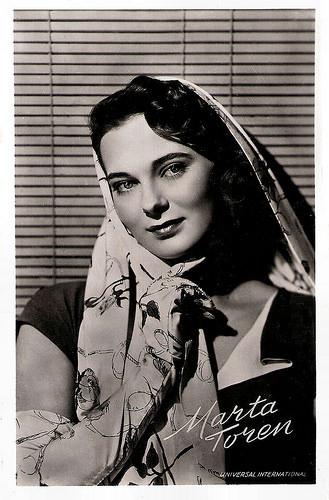
Dutch postcard, no. AX 197. Photo: Universal International.
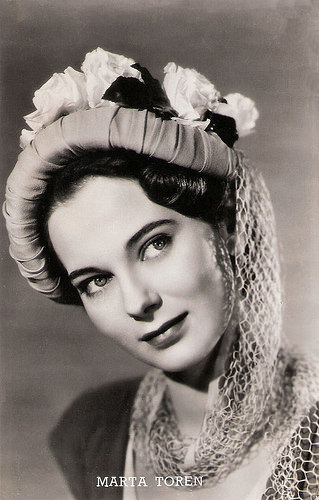
Dutch postcard by Van Leer's Fotodrukindustrie, Amsterdam, no. 1250. Photo: Universal International.
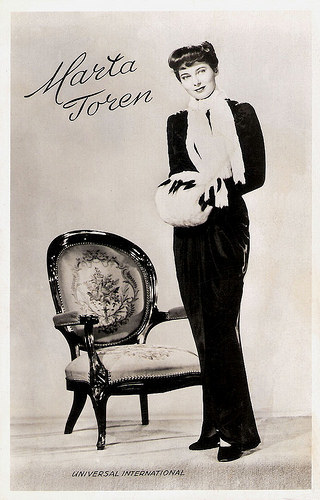
Dutch postcard, no. 3226. Photo: Universal International.
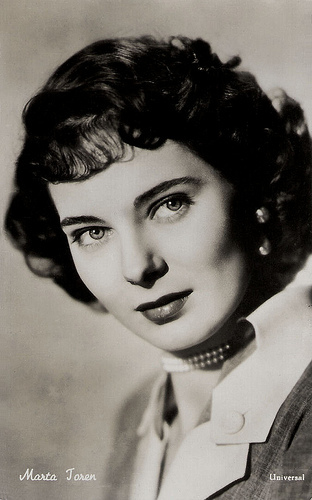
Vintage card. Photo: Universal International.
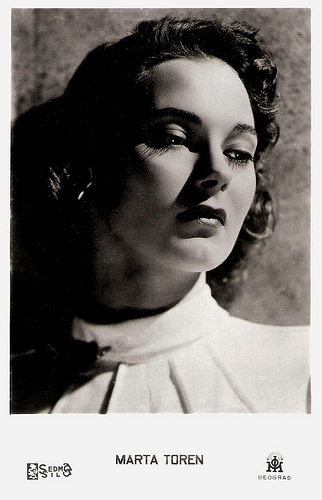
Yugoslavian postcard by Zebranjena. Photo: Sedmo Silo/IOM, Beograd (Belgrado).
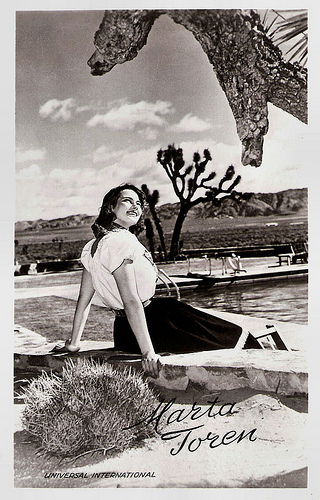
Dutch postcard by Uitgeverij Takken, no. 3225. Photo: Universal International.
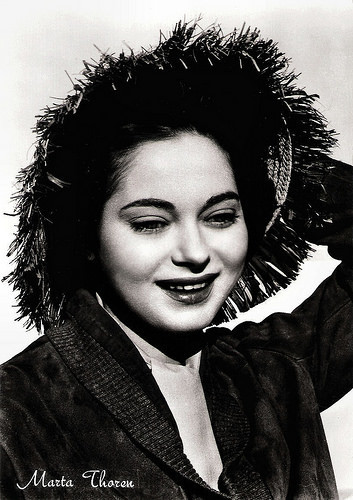
Italian postcard by Rotalfoto, Milano, no. 577. Photo: publicity still for La puerta abierta/The Open Door (César Fernández Ardavín, 1957).
Sources: Céline Colassin (CinéArtistes - French), Hal Erickson (AllMovie), (IMDb), Glamour Girls of the Silver Screen, Wikipedia and .
The title role is performed by Marta Toren (1926–1957), a Swedish-American stage and film actress of the 1940s and 1950s with mesmerising eyes. During her tragically short career, she spent more time in Hollywood and Italy than in her native country.

German postcard by Ufa, Berlin-Tempelhof, no FK 1079. Photo: Poletto / Union-Film. Publicity still for Maddalena (Augusto Gennina, 1954).

Italian postcard by B.F.F. Edit., no. 3048. Photo: Columbia CEAD.

Italian postcard by B.F.F. Edit. (Casa Editr. Ballerini & Fratini), Firenze (Florence), no. 2417. Photo: Universal International.

Norvegian postcard by Enerett K. Harstad, Kunstforlag, Oslo, no. 21. Photo: Universal International.

German postcard by F.J. Rüdel, Filmpostkartenverlag, Hamburg-Bergedorf, no. 431. Photo: Columbia. Publicity still for Sirocco (Curtis Bernhardt, 1951).
The Next Ingrid Bergman
Märta Torén was born in Stockholm, Sweden in 1926. Her father was Helge Toren, a major in the Life Guards regiment and, later, advertising manager for one of the daily newspapers. Her childhood was unremarkable although marred by the loss of her sister at an early age and the divorce of her parents.
The sensitive young girl dreamed to become an actress, but she was shy. She began ballet lessons under the renowned Vera Alexandrova. The lessons continued until age 14 and helped her to partly overcome her shyness.
She was an extra in the Swedish films Rospiggar (Schamyl Bauman, 1942), Ombyte av tåg/A Change of Trains (Hasse Ekman, 1943) and Eviga länkar/Eternal links (Rune Carlsten, 1946).
In 1946, her application to study acting at Dramatens elevskola (The Royal Dramatic Theater school) was accepted. She became a dedicated student under Anna Norris, a teacher who had also coached Ingrid Bergman .
After only one year, she already left her studies when she met American screen writer and talent scout Edwin Blum who was in Stockholm working on a script for RKO and looking for a leading lady. He arranged a screen test for her and not RKO but Universal-International offered her a seven-year contract.
Universal promoted her as the ‘next Ingrid Bergman ’. As Marta Toren, she made her Hollywood debut in a supporting part in Casbah (John Farrow, 1948) about the downfall of an exiled jewel thief (Tony Martin). The film was a musical remake of the French classic Pépé le Moko (Julien Duvivier, 1937) starring Jean Gabin .
Reviewer B.J. at IMDb writes: “Casbah is a film very alive with energy, style, suspense and romance. Brilliant casting; Tony Martin plays the suave thief with easy conviction and delivers the Harold Arlen songs skill, charm and gusto. Marta Toren was arguably the most beautiful woman in films, prior to the arrival of Audrey Hepburn .”
Publicity pictures focused on her beautiful eyes, which had a luminous quality with color shifting from blue to gray to greenish hues and had a fairly slight slant, giving them a faintly Oriental look. The emphasis on her eyes reached a peak with a Life magazine cover portrait in 1949 that graphically confirmed what all the hype was about.
Toren quickly appeared in a total of ten Hollywood movies. She appeared opposite James Mason in the film noir One Way Street (Hugo Fregonese, 1950), and opposite Humphrey Bogart in the Casablanca style Sirocco (Curtis Bernhardt, 1951) set in Syria, but most of her other Hollywood films are not worth remembering.

Dutch postcard by Takken, Utrecht. Photo: Universal International.

Vintage card. Photo: Universal International.

Vintage postcard, no. 505. Photo: Universal International.

Dutch postcard, no 3374. Photo: Universal International.

German postcard by Kolibri-Verlag, no 936. Photo: Columbia. Publicity still for Assignment: Paris (Robert Parrish, 1952).
Oedipal Relationship
In 1952 Märta Torén became a naturalized American citizen and she got married to American director and film writer Leonardo Bercovici. They would have a daughter, Christina.
She also got offers for film parts from Rome, and these roles were more demanding than what Hollywood offered her. So the family settled in Rome. There she played the wife of composer Giacomo Puccini ( Gabriele Ferzetti ) in the biopic Puccini/The Life of Puccini (Carmine Gallone, 1953).
She won awards for the highly acclaimed drama Maddalena/Magdalene (Augusto Genina, 1954) with Gino Cervi . In La vena d'oro/The Golden Vein (Mauro Bolognini, 1955) she played a young stepmother in an oedipal relationship with her only son (played by the then 16-year-old Mario Girotti aka Terence Hill).
Then her husband directed her in Tormento d'amore/Torment of Love (Leonardo Bercovici, Claudio Gora, 1956) with Massimo Serato .
In late 1956, on a trip to Stockholm an actor approached her with an offer to replace leading lady Eva Henning in a current play by J.B. Priestly, Mr. Kettle and Mrs. Moon. The thought of performing before a hometown audience reportedly was as frightening as it was appealing to Toren.
Ingrid Bergman and other theater friends warned her about the hostile reception she was likely to encounter in her hometown but her debut performance instead got a warm reception from both audiences and critics. In February 1957 she appeared again on stage in Mr. Kettle and Mrs. Moon at Stockholm's Alléteatern (Allee Theatre).
After a performance she suddenly fainted before the door of her dressing room. In the hospital doctors diagnosed that she was stricken with a brain hemorrhage. Her husband rushed to the hospital while their daughter was in London, where Marta planned to do film work after her stage appearance. Tragically, she died two days later in the Stockholm hospital. Märta Torén was only 31.

Dutch postcard, no. AX 197. Photo: Universal International.

Dutch postcard by Van Leer's Fotodrukindustrie, Amsterdam, no. 1250. Photo: Universal International.

Dutch postcard, no. 3226. Photo: Universal International.

Vintage card. Photo: Universal International.

Yugoslavian postcard by Zebranjena. Photo: Sedmo Silo/IOM, Beograd (Belgrado).

Dutch postcard by Uitgeverij Takken, no. 3225. Photo: Universal International.

Italian postcard by Rotalfoto, Milano, no. 577. Photo: publicity still for La puerta abierta/The Open Door (César Fernández Ardavín, 1957).
Sources: Céline Colassin (CinéArtistes - French), Hal Erickson (AllMovie), (IMDb), Glamour Girls of the Silver Screen, Wikipedia and .
Published on June 30, 2017 22:00
June 29, 2017
Rubi Dalma
One of the programmes at
Il Cinema Ritrovato
we follow is Augusto Genina: an Italian in Europe. Augusto Genina (1892-1957) is one of the most cosmopolitan directors of Italian film history. Interesting is his Cielo sulla palude (1949), a Catholic variant of Neorealism. Among the cast is Italian stage and screen actress Rubi Dalma (1906-1994), aka Rubi D'Alma, who often played stereotyped roles of sophisticated and sometimes snobbish noblewomen. Besides Genina, she also worked with such directors as Righelli, Camerini, Guazzoni, Zampa and Antonioni.
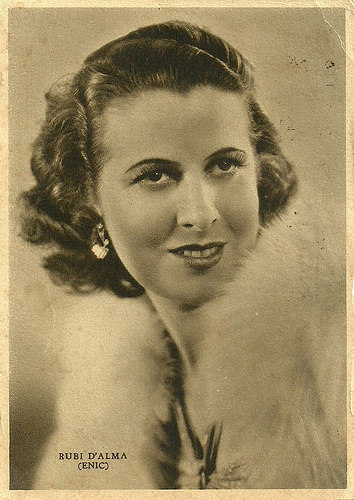
Italian postcard by Rizzoli, Milano, 1940. Photo: E.N.I.C.
Daughter of a noble family
Rubi Dalma was born as Giusta Manca di Villahermosa in Milan in 1996. She came from an aristocratic family from the Sardinian town of Sassari.
In Milan, she was discovered by Camillo Mastrocinque, who let her make her film debut in Regina della Scala/Queen of the Scala (Guido Salvini, 1936), with a bit part basically as herself: a daughter of a noble family.
Her next film, the romantic comedy Il signor Max/Mister Max (Mario Camerini, 1937), introduced her to a big audience, with her stage name Rubi Dalma. She plays the sophisticated lady Paola, courted in vain by Gianni ( Vittorio De Sica ), a newspaper stand vendor who pretends to be the rich snob Max Varaldo.
When Lauretta ( Assia Noris ), donna Paola’s maid and governess of Paola’s little sister Pucci (Adonella), falls in love with Gianni, Gianni has to change roles constantly to court both Paola and Lauretta. Of course this is bound to go wrong. Costumes were by Gino Carlo Sensani, sets by Gastone Medin.

Italian postcard by Ballerini & Fratini Editori, Firenze, no. 2390. Photo: Generalcine. Rubi Dalma in Batticuore/Heartbeat (Mario Camerini, 1939).
Petty bourgeois morals, crowned my marriage
Because of her origin, Rubi Dalma perfectly incarnated the nobility on the screen, which resulted in modern and historical roles tied to the Italian aristocracy, such as Batticuore/Heartbeat (Mario Camerini, 1939) again with Noris in the female lead, and Rose scarlatte/Red Roses (Giuseppe Amato, Vittorio De Sica, 1940) with Renée Saint-Cyr and De Sica himself.
Similar parts Dalma had in Tempesta sul golfo/Tempest over the Gulf (Gennaro Righelli, 1943) in which Dalma played the Austrian Empress Maria Theresia, Enrico IV (Giorgio Pastinà, 1943) based on Luigi Pirandello’s play and starring Osvaldo Valenti and Clara Calamai , and Il cavaliere del sogno/Life of Donizetti (Camillo Mastrocinque, 1947), a biopic on the composer Donizetti, starring Amedeo Nazzari and Mariella Lotti .
In Renato Castellani’s adaptation of Aleksandr Pushkin’s The Shot, Un colpo di pistola/A Pistol Shot (1942), she is the aunt of Mascia ( Assia Noris ), courted by both Foscho Giacchetti and Antonio Centa .
In Luigi Zampa’s C’è sempre un ma!/There Is Always a But! (1943), Dalma plays one of two mothers who lead a party life and need to be brought back to earth (that is: petty bourgeois morals, crowned my marriage) by their daughters, played by Carla Del Poggio and Adriana Benetti. While shooting in 1942 took six months and distribution also dragged on, the film came out in 1943 in a moment the average Italian was not in the mood of a Hollywood-like script in which children need to re-educate their parents after the Roaring Twenties.
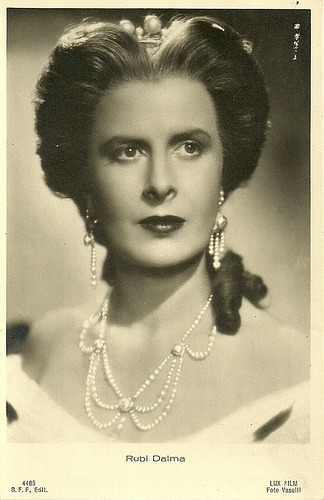
Italian postcard by Casa Editrice Ballerini & Fratini, Firenze, no. 4485. Photo: Vaselli / Lux Film.
Michelangelo Antonioni
During her career, Rubi Dalma was directed in various films and stage plays by such directors as Gennaro Righelli, Mario Camerini, Enrico Guazzoni, Luigi Zampa and Michelangelo Antonioni. Dalma participated for instance in the historical production Enrico Meucci (Enrico Guazzoni, 1940), a biopic of the homonymous inventor, starring Luigi Pavese.
She played the wife of marshal Bertrand in Sant’Elena, piccola isola/Saint-Helen, Little Island (Umberto Scarpelli, Renato Simoni, 1943) on Napoleon’s last exile and starring Ruggero Ruggeri as Napoleon.
After the war she mainly played character parts. Among her last roles was that of the countess Teneroni in Augusto Genina’s Cielo sulla palude/Heaven over the Marshes (1949), on the young Christian martyr Maria Goretti (played by Ines Orsini), and masterfully cinematographed by Aldo Graziati.
Another late part was that of the snob friend of Paola ( Lucia Bosè ) in Michelangelo Antonioni’s Cronaca di un amore/Story of a Love Affair (1950).
Dalma’s last part was, again, that of a countess in Claudio Gora’s Febbre di vivere/Eager to Live (1953), on the young spendthrift and gambling snob Massimo ( Massimo Serato ), who betrays his beloved Elena ( Anna Maria Ferrero ) and wants her to abort their child, while his friend Daniele ( Marcelllo Mastroianni ), released from prison, discovers Massimo was responsible for his imprisonment. Things go from bad to worse with Massimo.
After this film, Dalma decided to finish her career as actress. At the age of 88, Rubi Dalma died in 1994 in Castel Gandolfo near Rome.
Trailer Il signor Max/Mister Max (Mario Camerini, 1937). Source: ripleysfilm (YouTube).
Sources: Wikipedia (English, French and Italian), and .

Italian postcard by Rizzoli, Milano, 1940. Photo: E.N.I.C.
Daughter of a noble family
Rubi Dalma was born as Giusta Manca di Villahermosa in Milan in 1996. She came from an aristocratic family from the Sardinian town of Sassari.
In Milan, she was discovered by Camillo Mastrocinque, who let her make her film debut in Regina della Scala/Queen of the Scala (Guido Salvini, 1936), with a bit part basically as herself: a daughter of a noble family.
Her next film, the romantic comedy Il signor Max/Mister Max (Mario Camerini, 1937), introduced her to a big audience, with her stage name Rubi Dalma. She plays the sophisticated lady Paola, courted in vain by Gianni ( Vittorio De Sica ), a newspaper stand vendor who pretends to be the rich snob Max Varaldo.
When Lauretta ( Assia Noris ), donna Paola’s maid and governess of Paola’s little sister Pucci (Adonella), falls in love with Gianni, Gianni has to change roles constantly to court both Paola and Lauretta. Of course this is bound to go wrong. Costumes were by Gino Carlo Sensani, sets by Gastone Medin.

Italian postcard by Ballerini & Fratini Editori, Firenze, no. 2390. Photo: Generalcine. Rubi Dalma in Batticuore/Heartbeat (Mario Camerini, 1939).
Petty bourgeois morals, crowned my marriage
Because of her origin, Rubi Dalma perfectly incarnated the nobility on the screen, which resulted in modern and historical roles tied to the Italian aristocracy, such as Batticuore/Heartbeat (Mario Camerini, 1939) again with Noris in the female lead, and Rose scarlatte/Red Roses (Giuseppe Amato, Vittorio De Sica, 1940) with Renée Saint-Cyr and De Sica himself.
Similar parts Dalma had in Tempesta sul golfo/Tempest over the Gulf (Gennaro Righelli, 1943) in which Dalma played the Austrian Empress Maria Theresia, Enrico IV (Giorgio Pastinà, 1943) based on Luigi Pirandello’s play and starring Osvaldo Valenti and Clara Calamai , and Il cavaliere del sogno/Life of Donizetti (Camillo Mastrocinque, 1947), a biopic on the composer Donizetti, starring Amedeo Nazzari and Mariella Lotti .
In Renato Castellani’s adaptation of Aleksandr Pushkin’s The Shot, Un colpo di pistola/A Pistol Shot (1942), she is the aunt of Mascia ( Assia Noris ), courted by both Foscho Giacchetti and Antonio Centa .
In Luigi Zampa’s C’è sempre un ma!/There Is Always a But! (1943), Dalma plays one of two mothers who lead a party life and need to be brought back to earth (that is: petty bourgeois morals, crowned my marriage) by their daughters, played by Carla Del Poggio and Adriana Benetti. While shooting in 1942 took six months and distribution also dragged on, the film came out in 1943 in a moment the average Italian was not in the mood of a Hollywood-like script in which children need to re-educate their parents after the Roaring Twenties.

Italian postcard by Casa Editrice Ballerini & Fratini, Firenze, no. 4485. Photo: Vaselli / Lux Film.
Michelangelo Antonioni
During her career, Rubi Dalma was directed in various films and stage plays by such directors as Gennaro Righelli, Mario Camerini, Enrico Guazzoni, Luigi Zampa and Michelangelo Antonioni. Dalma participated for instance in the historical production Enrico Meucci (Enrico Guazzoni, 1940), a biopic of the homonymous inventor, starring Luigi Pavese.
She played the wife of marshal Bertrand in Sant’Elena, piccola isola/Saint-Helen, Little Island (Umberto Scarpelli, Renato Simoni, 1943) on Napoleon’s last exile and starring Ruggero Ruggeri as Napoleon.
After the war she mainly played character parts. Among her last roles was that of the countess Teneroni in Augusto Genina’s Cielo sulla palude/Heaven over the Marshes (1949), on the young Christian martyr Maria Goretti (played by Ines Orsini), and masterfully cinematographed by Aldo Graziati.
Another late part was that of the snob friend of Paola ( Lucia Bosè ) in Michelangelo Antonioni’s Cronaca di un amore/Story of a Love Affair (1950).
Dalma’s last part was, again, that of a countess in Claudio Gora’s Febbre di vivere/Eager to Live (1953), on the young spendthrift and gambling snob Massimo ( Massimo Serato ), who betrays his beloved Elena ( Anna Maria Ferrero ) and wants her to abort their child, while his friend Daniele ( Marcelllo Mastroianni ), released from prison, discovers Massimo was responsible for his imprisonment. Things go from bad to worse with Massimo.
After this film, Dalma decided to finish her career as actress. At the age of 88, Rubi Dalma died in 1994 in Castel Gandolfo near Rome.
Trailer Il signor Max/Mister Max (Mario Camerini, 1937). Source: ripleysfilm (YouTube).
Sources: Wikipedia (English, French and Italian), and .
Published on June 29, 2017 22:00
Paul van Yperen's Blog
- Paul van Yperen's profile
- 13 followers
Paul van Yperen isn't a Goodreads Author
(yet),
but they
do have a blog,
so here are some recent posts imported from
their feed.



